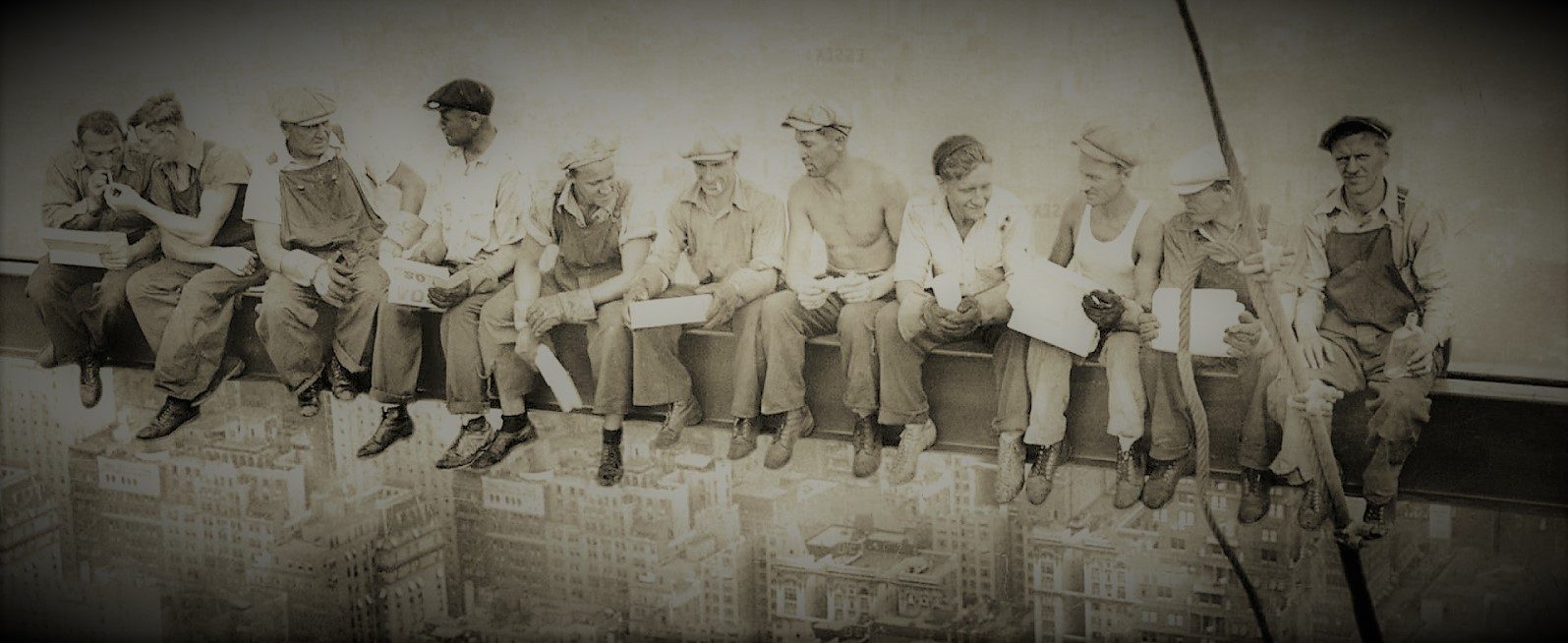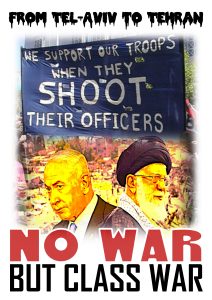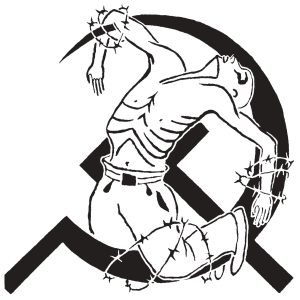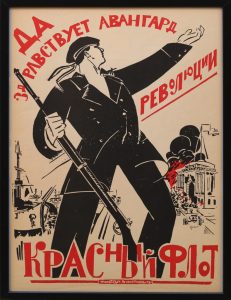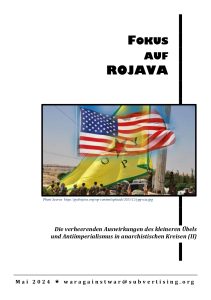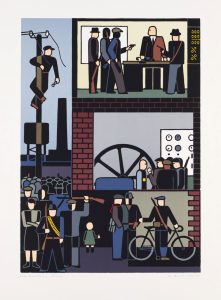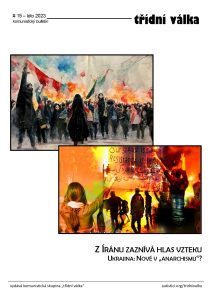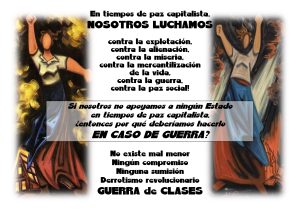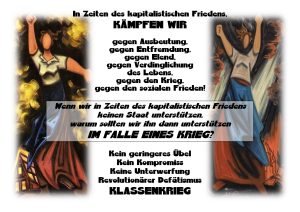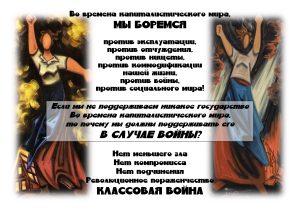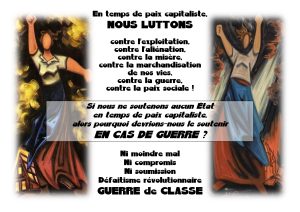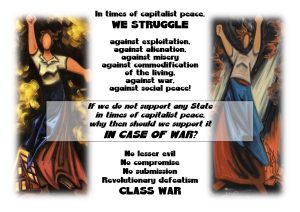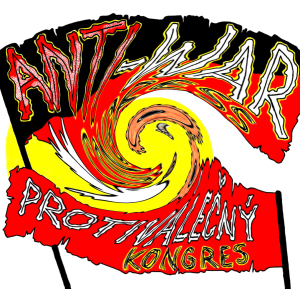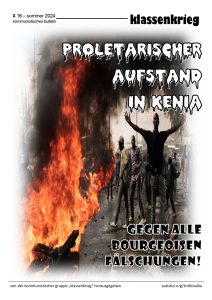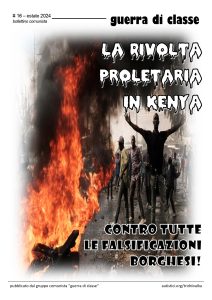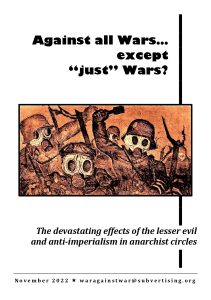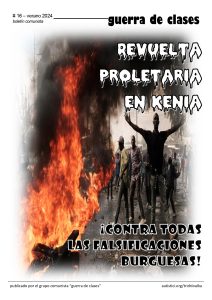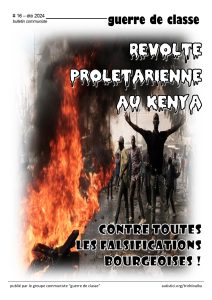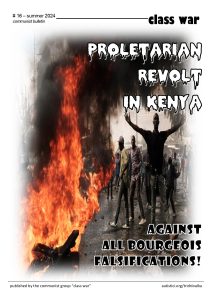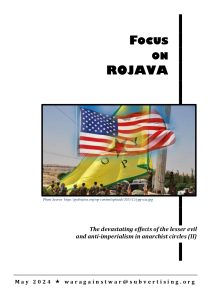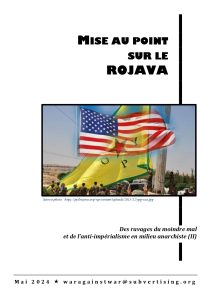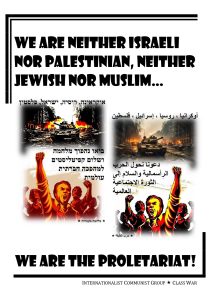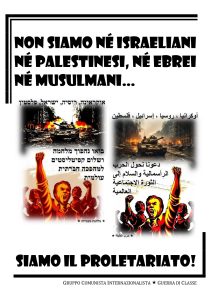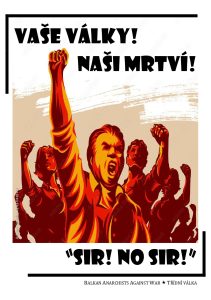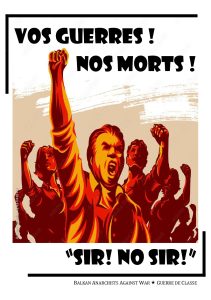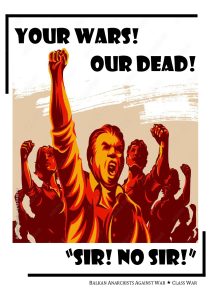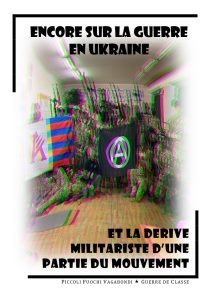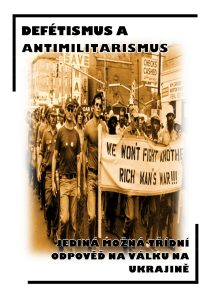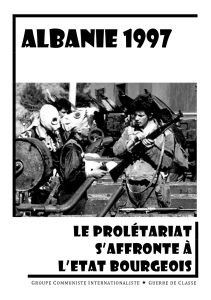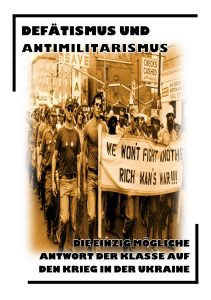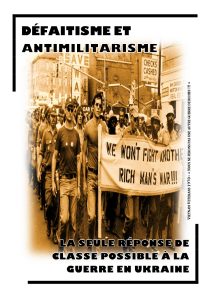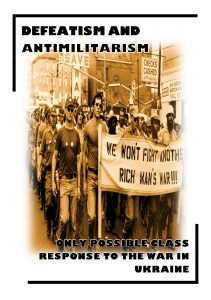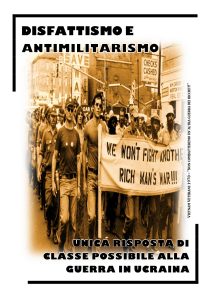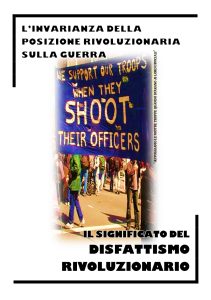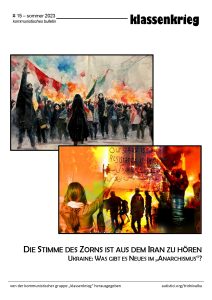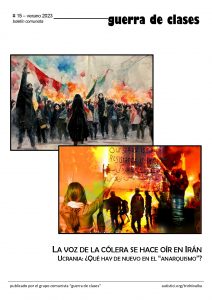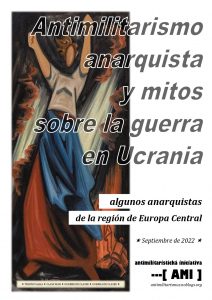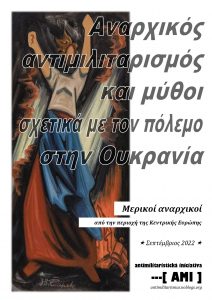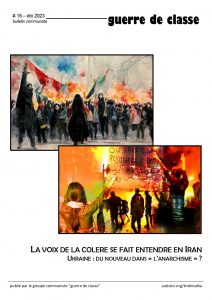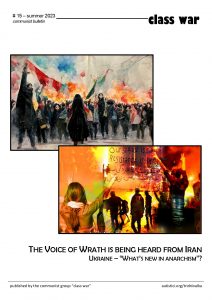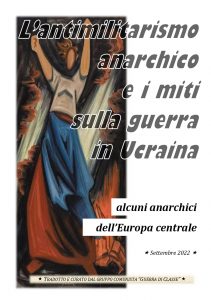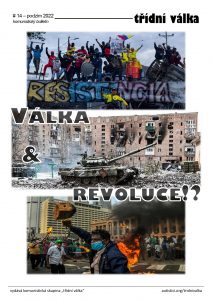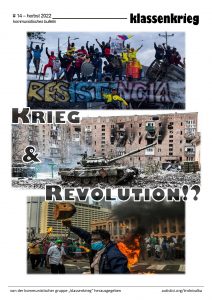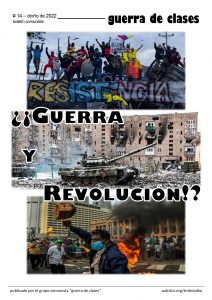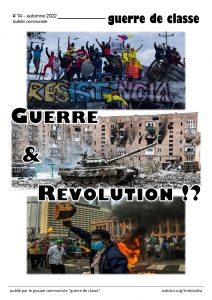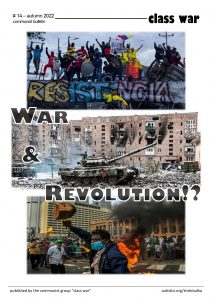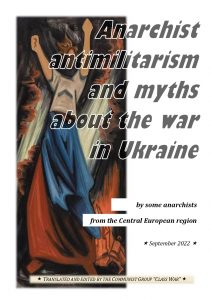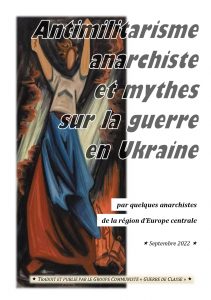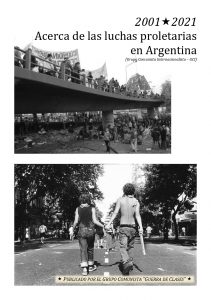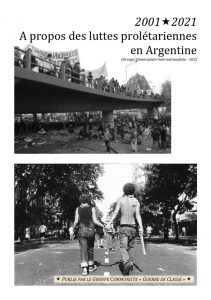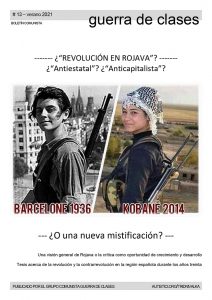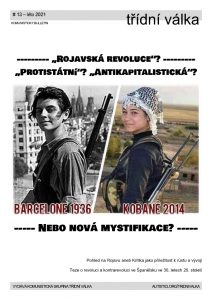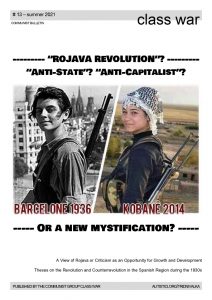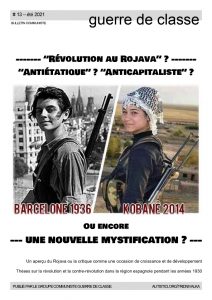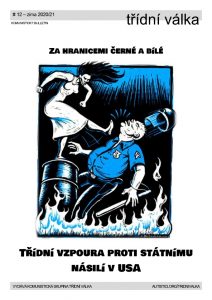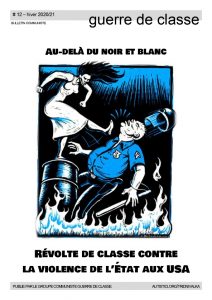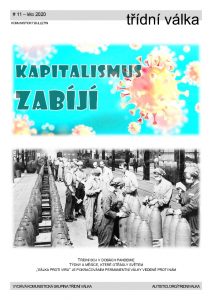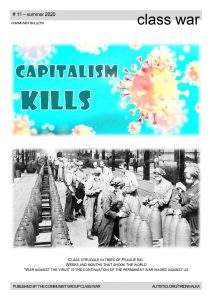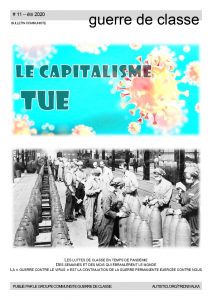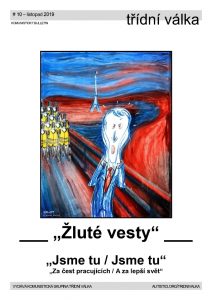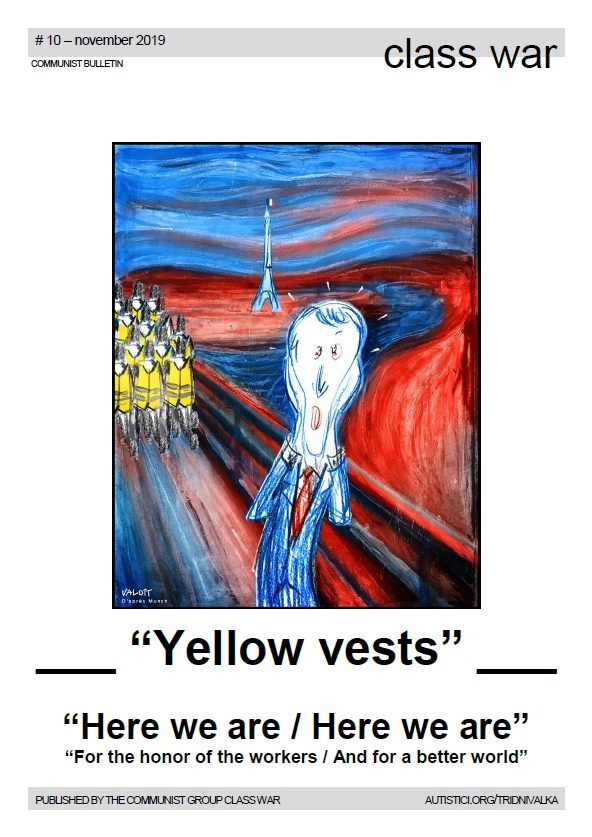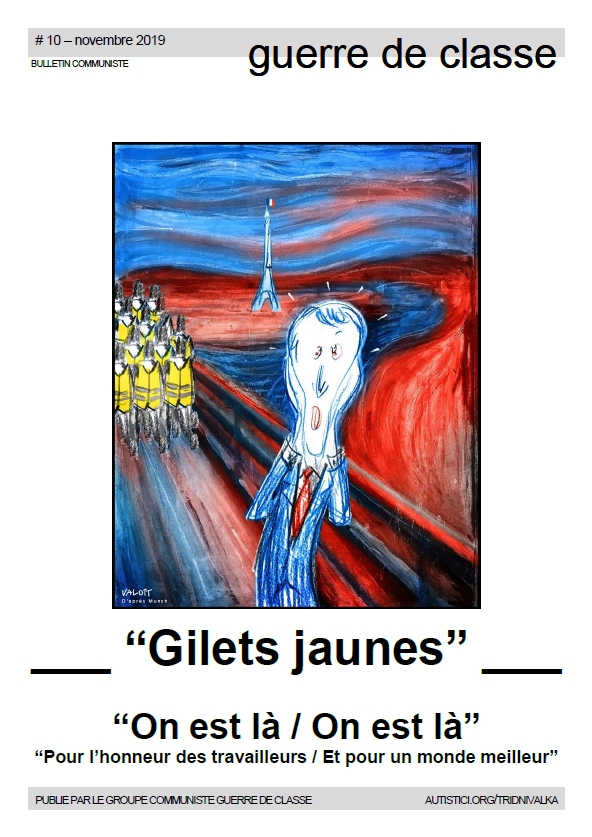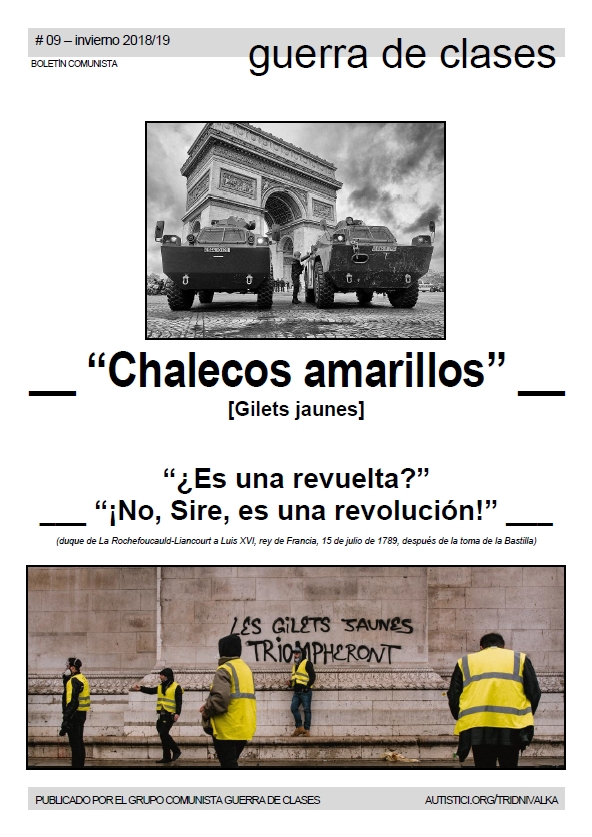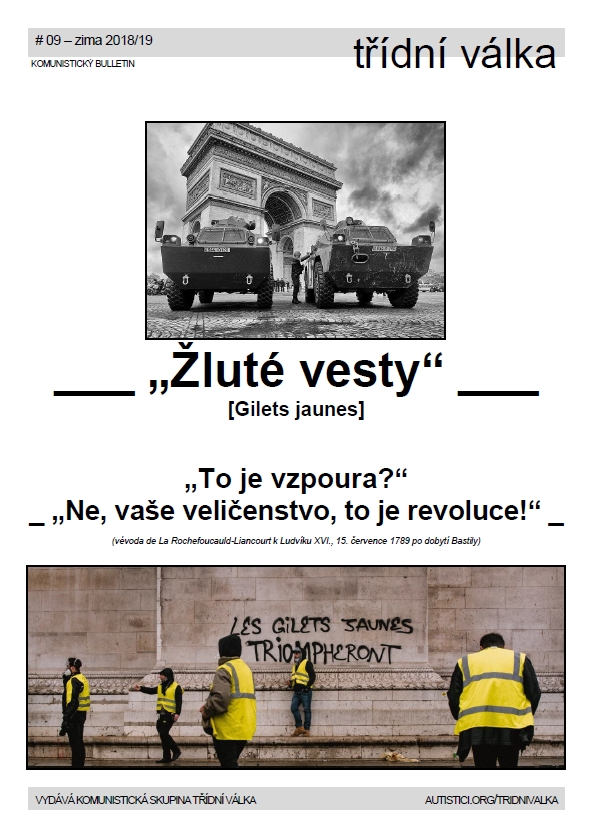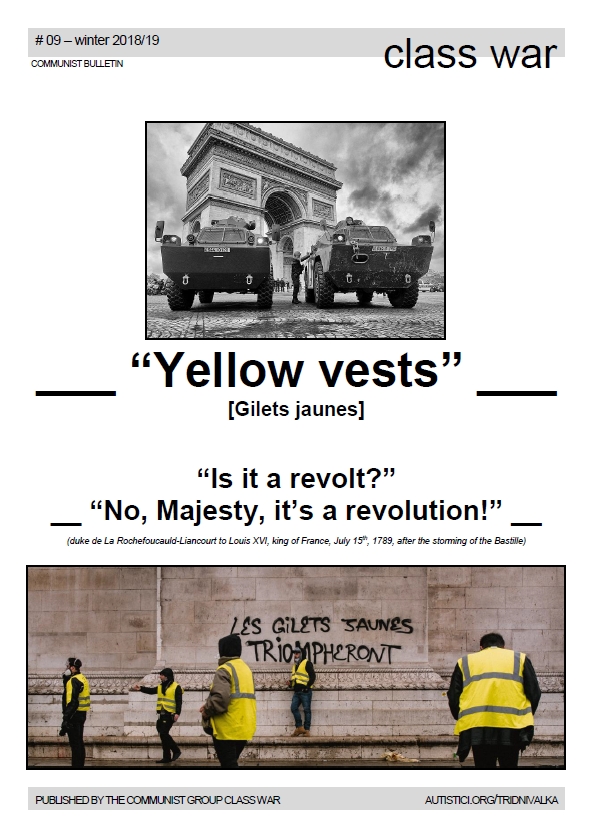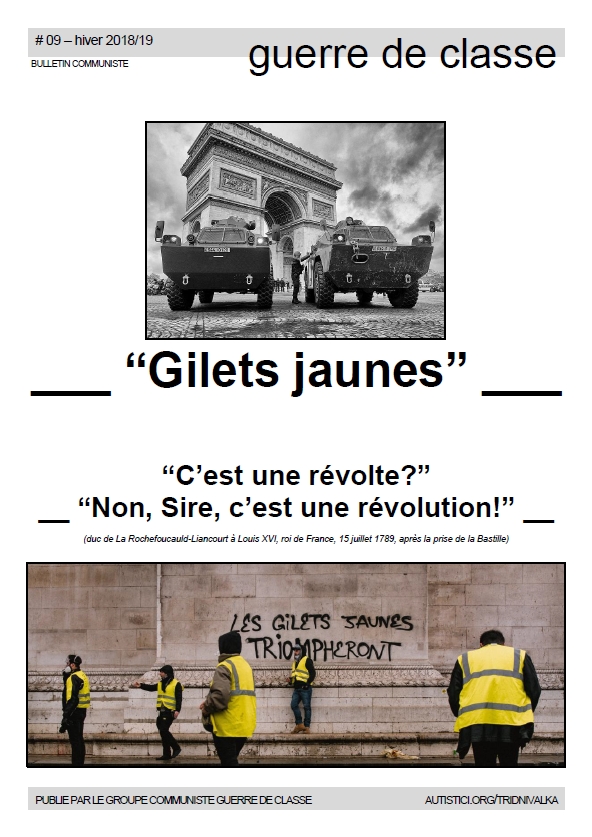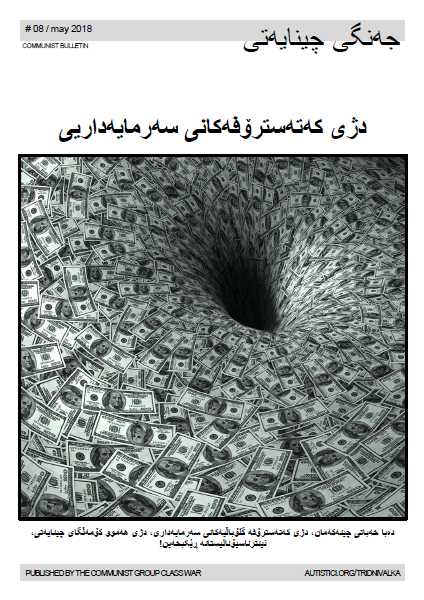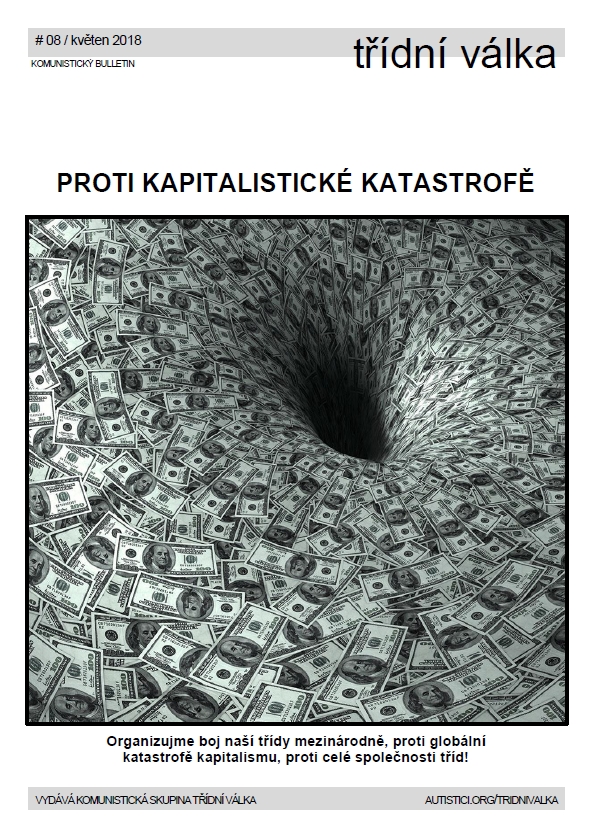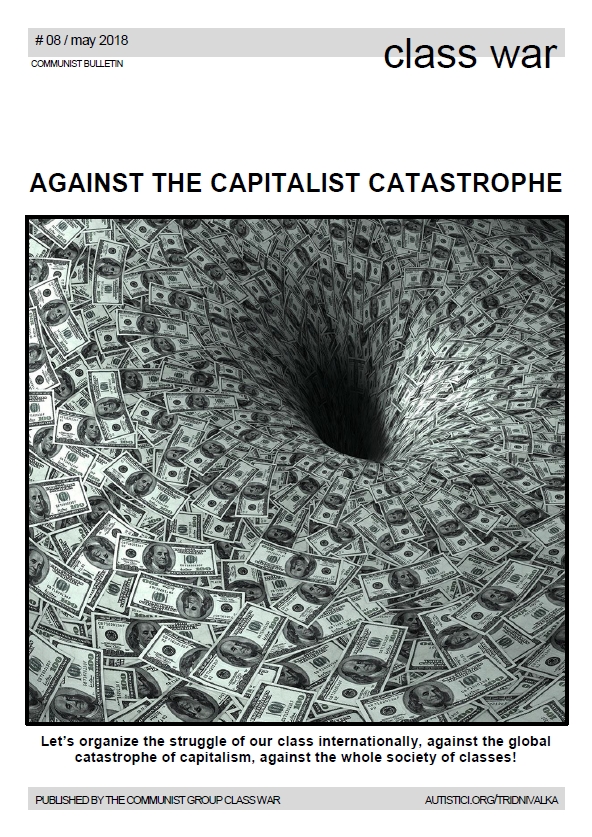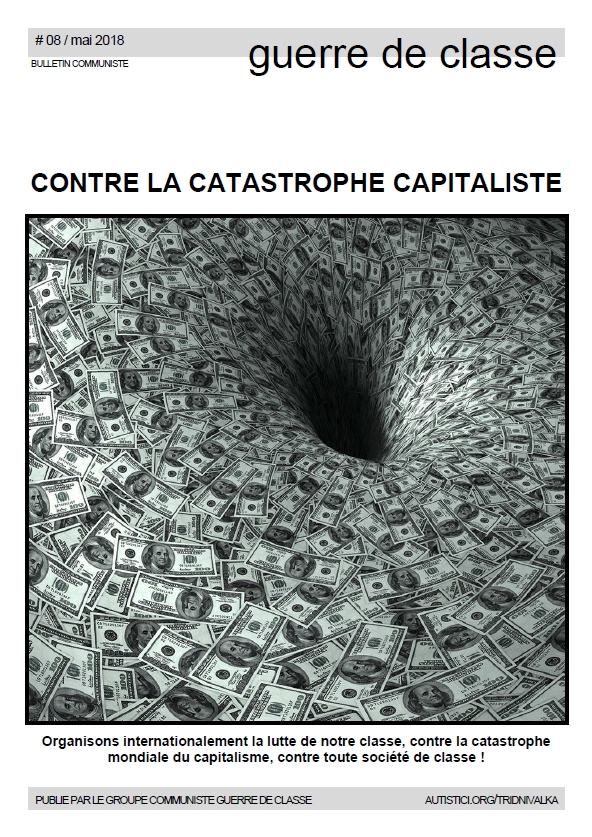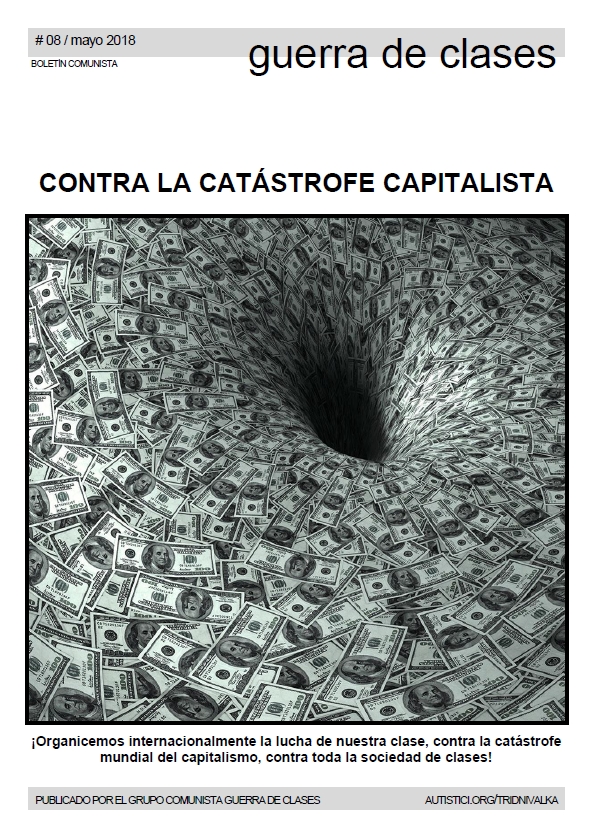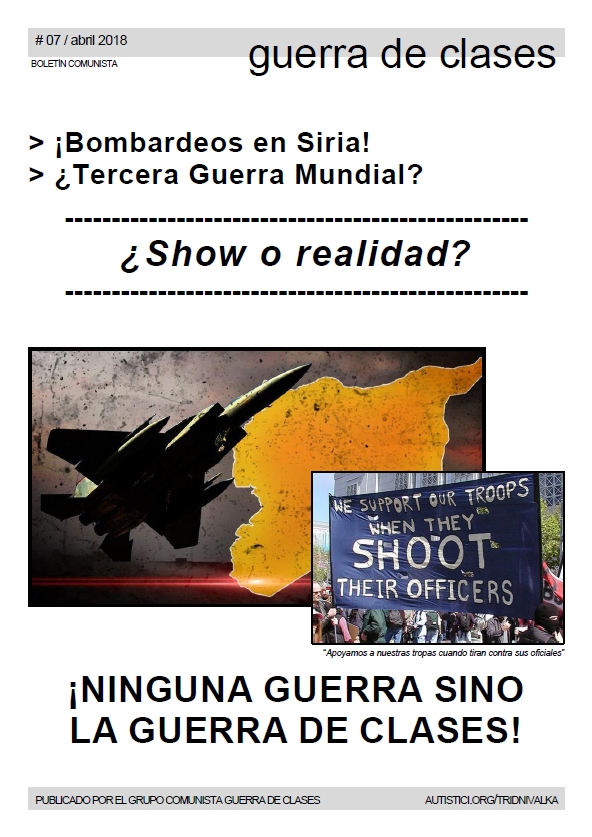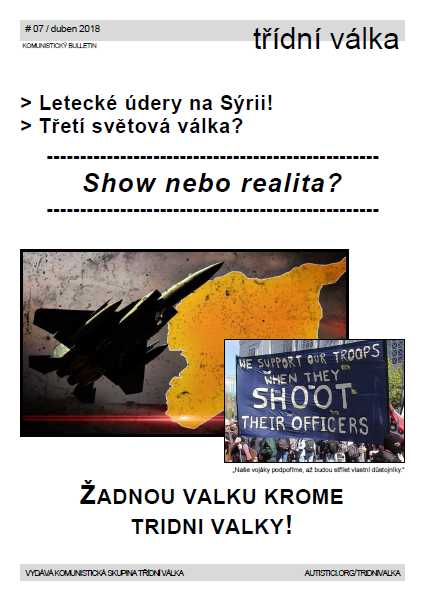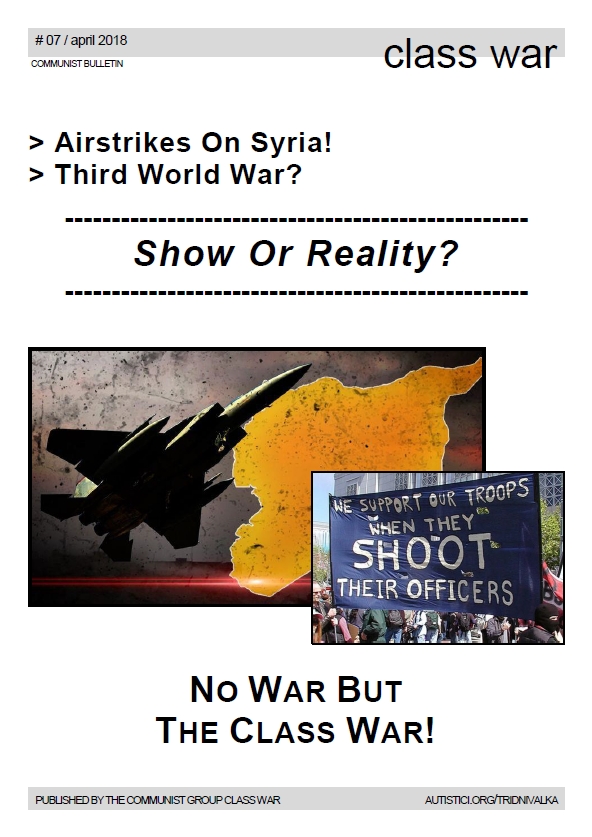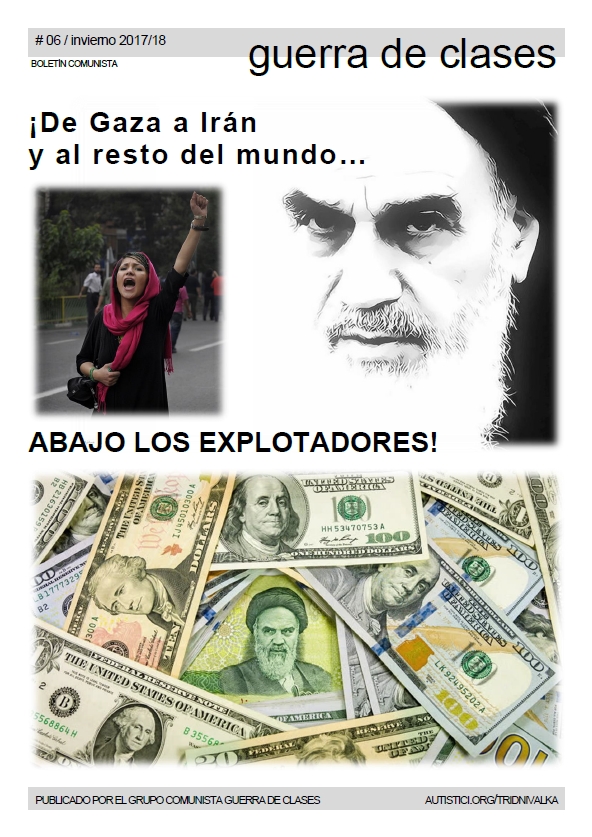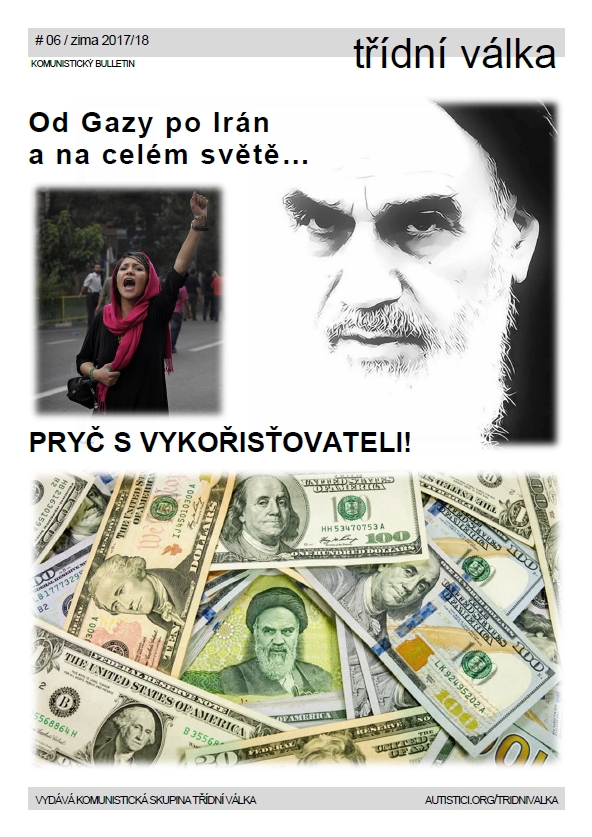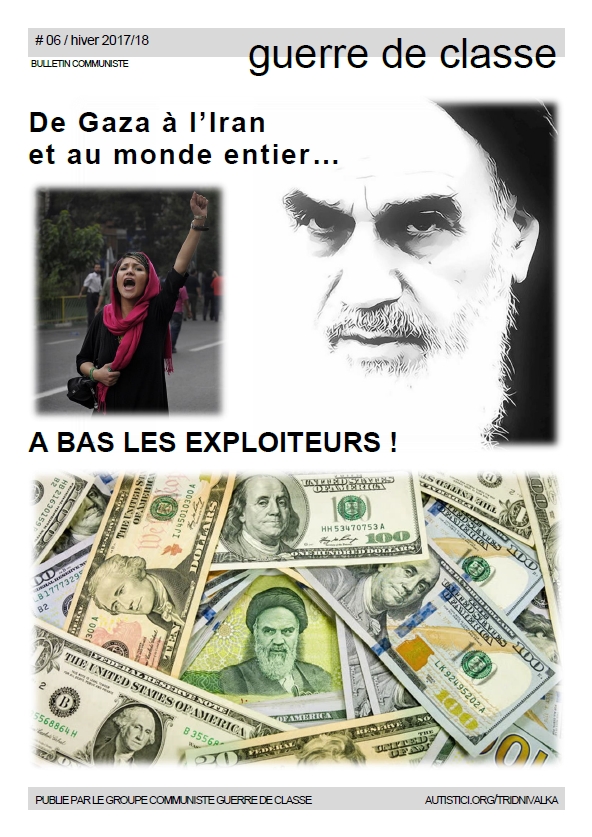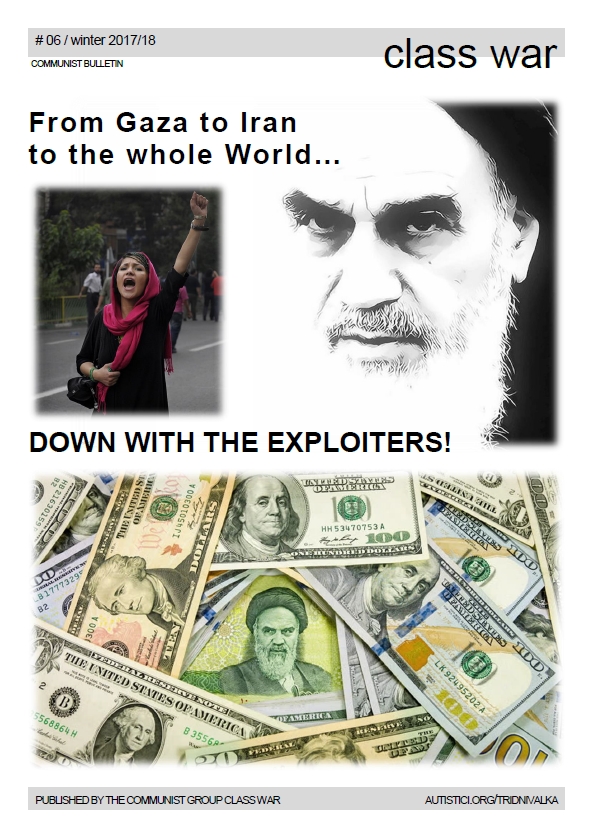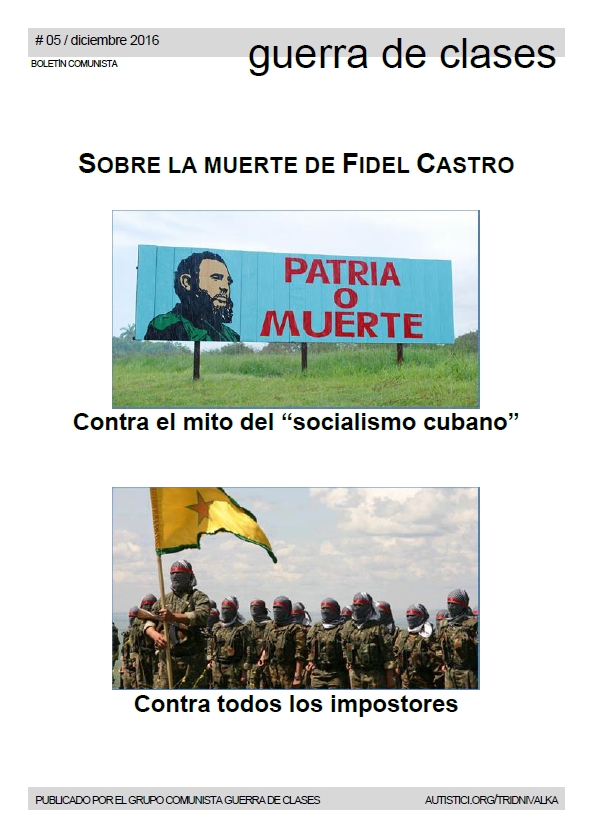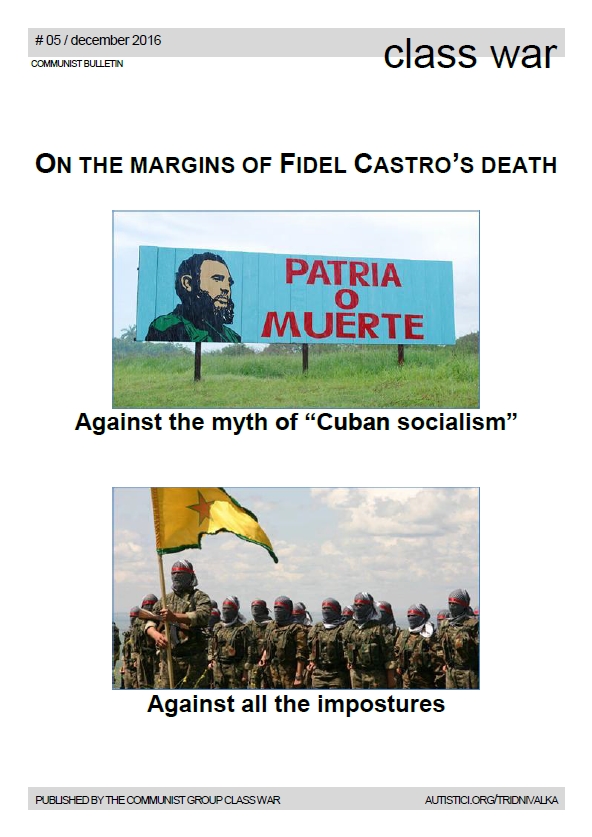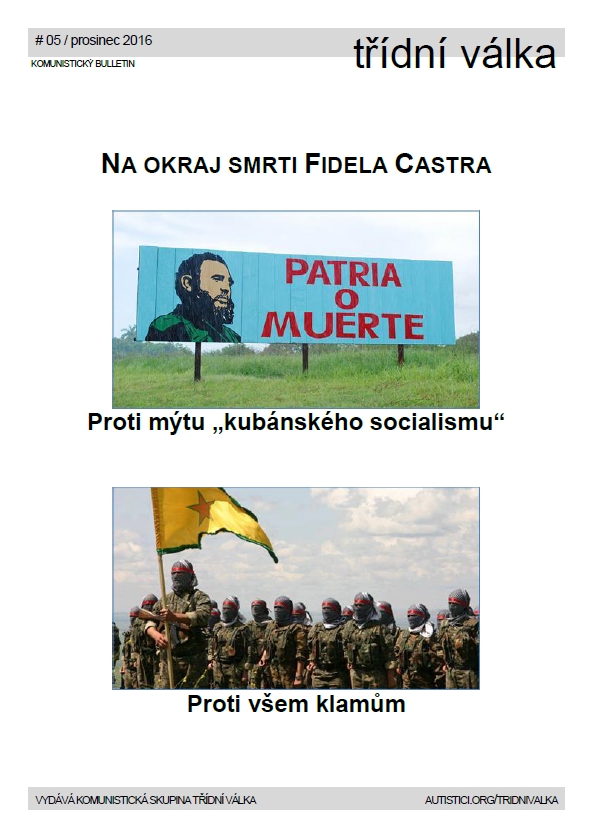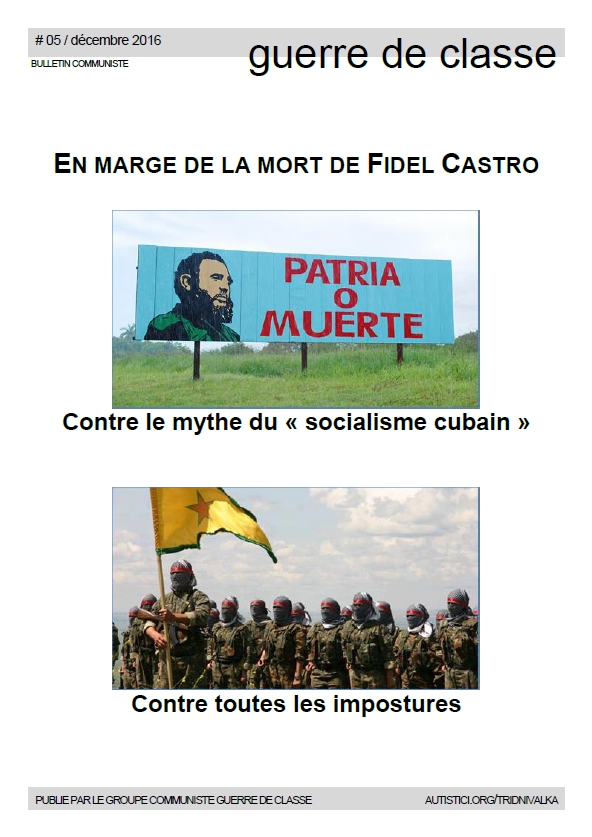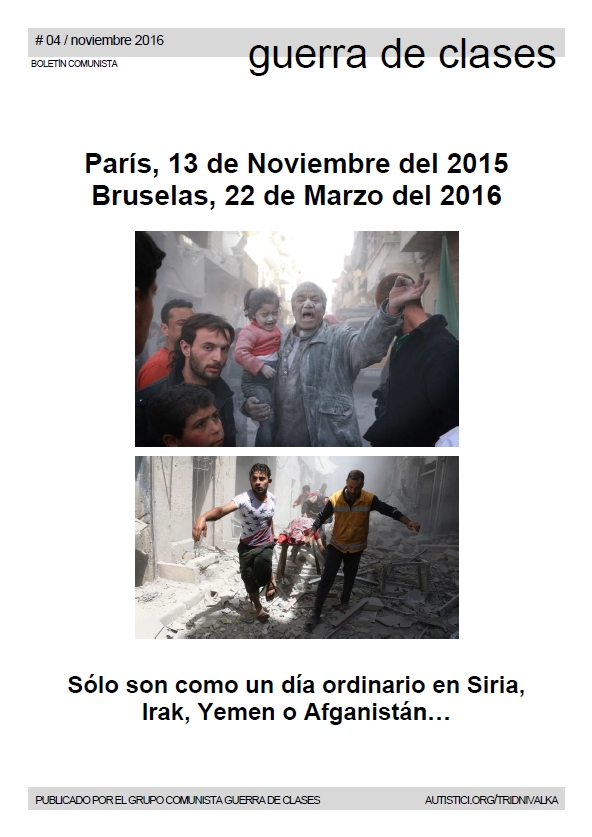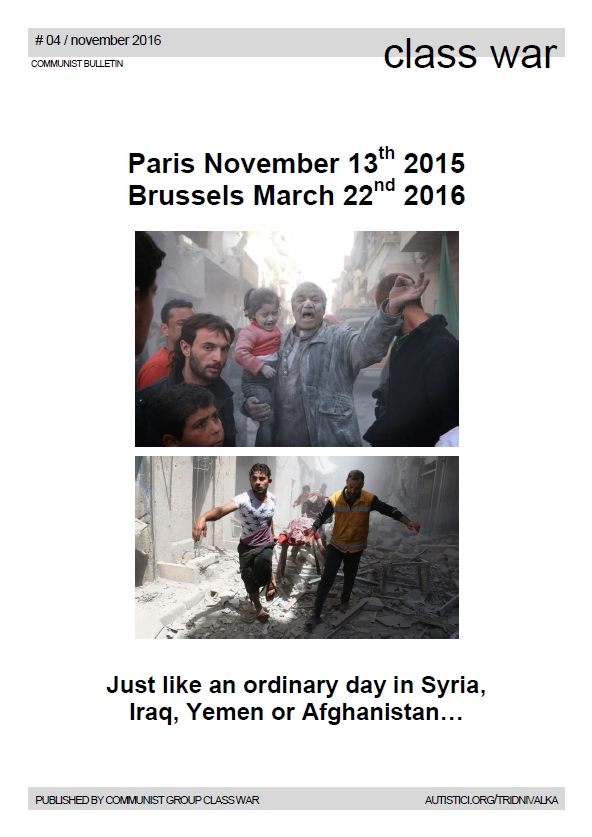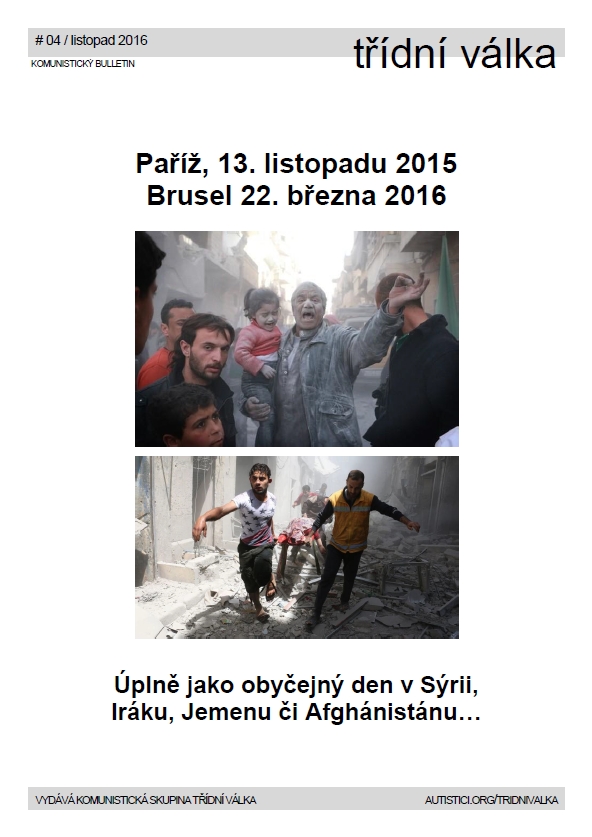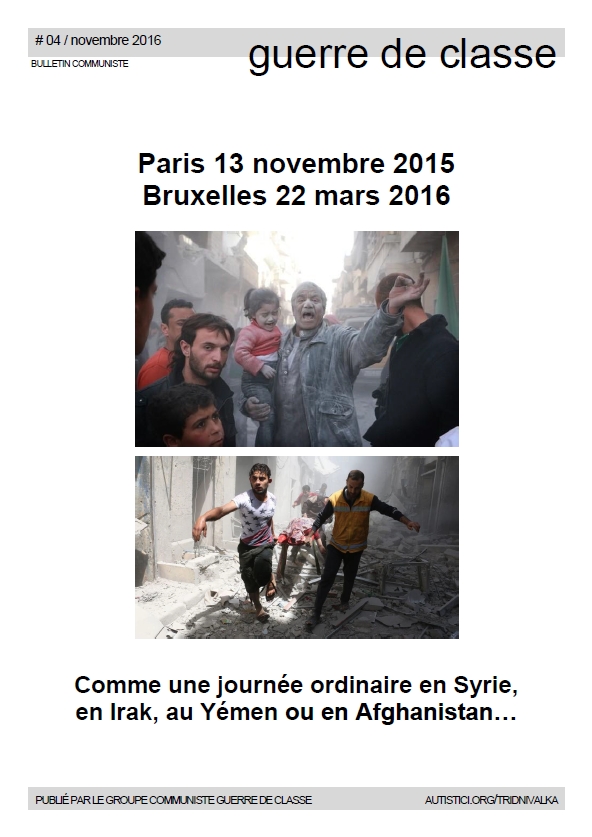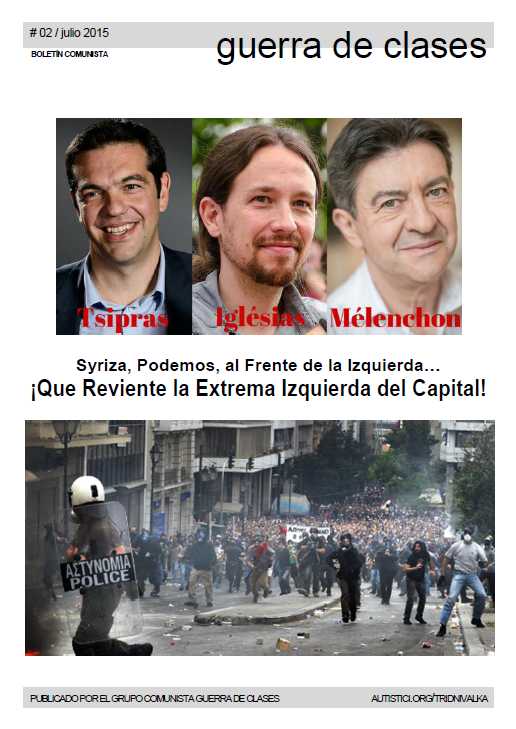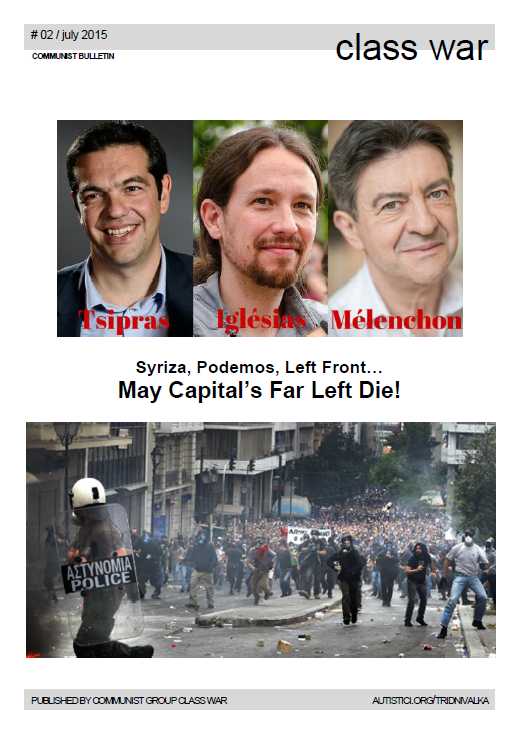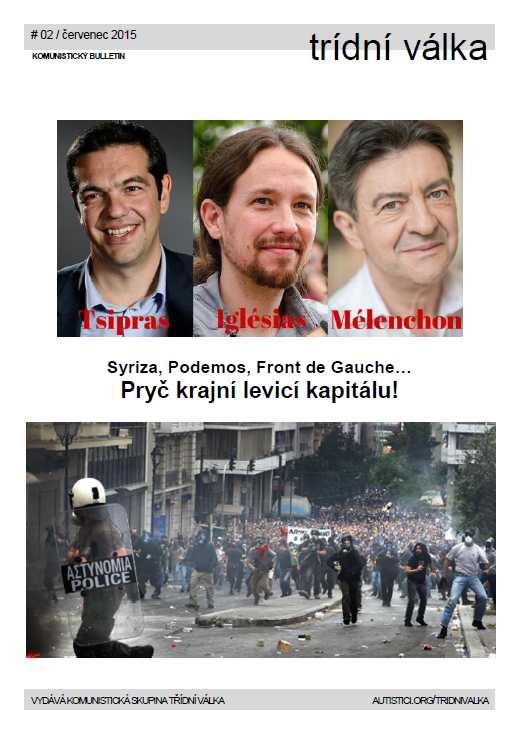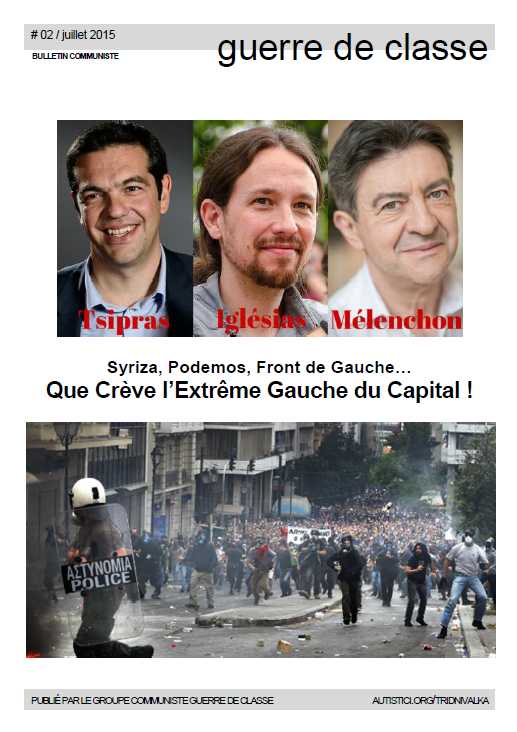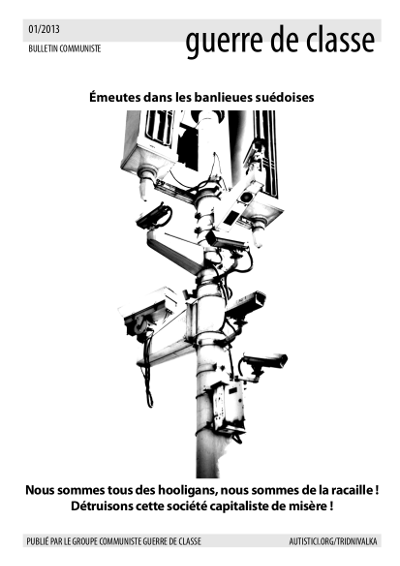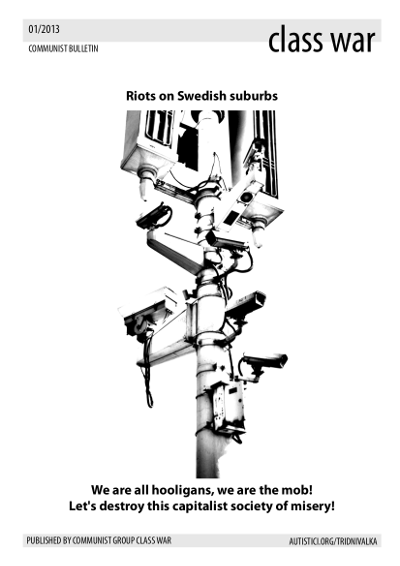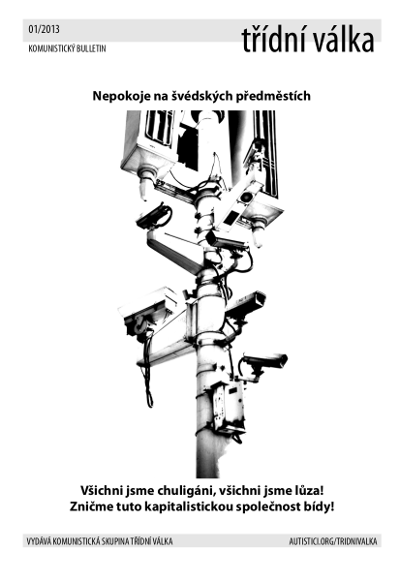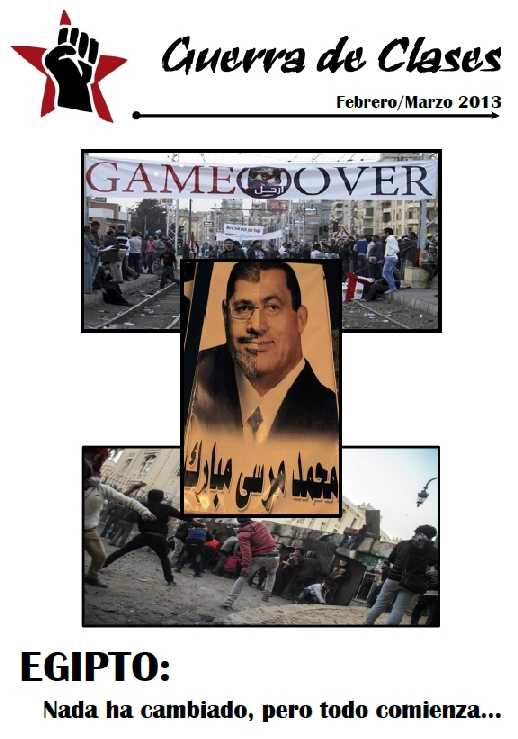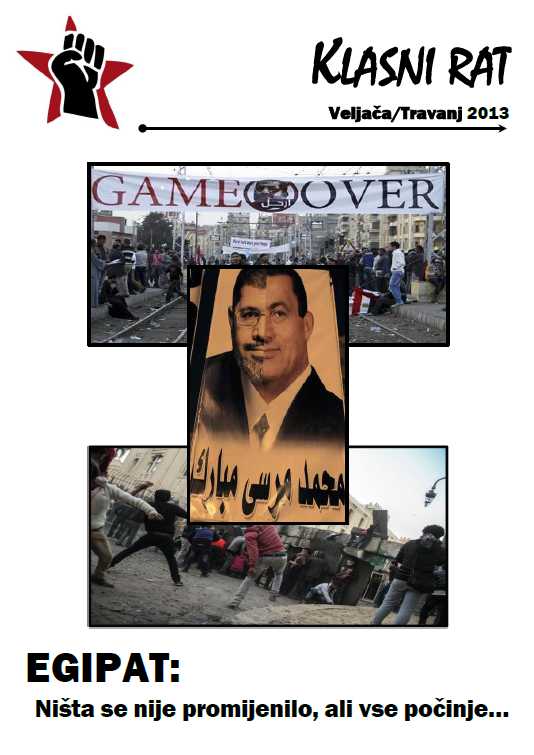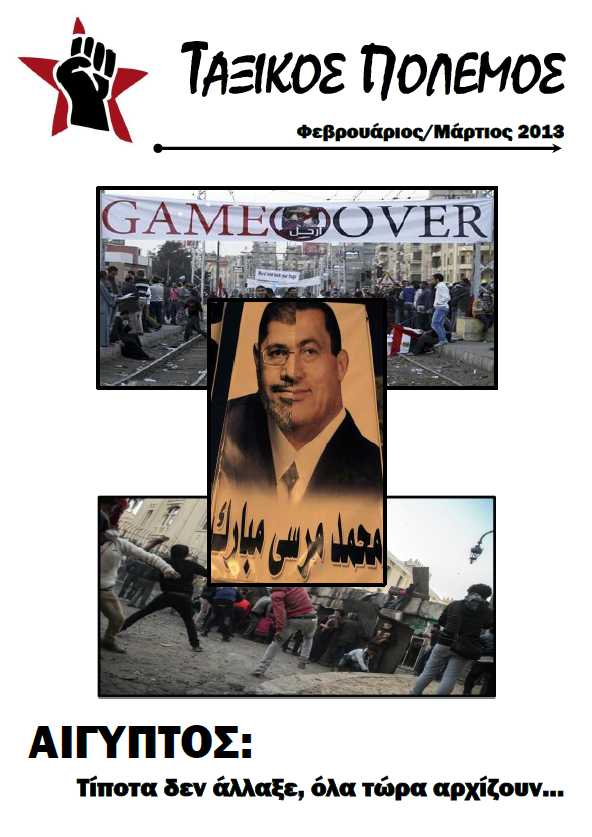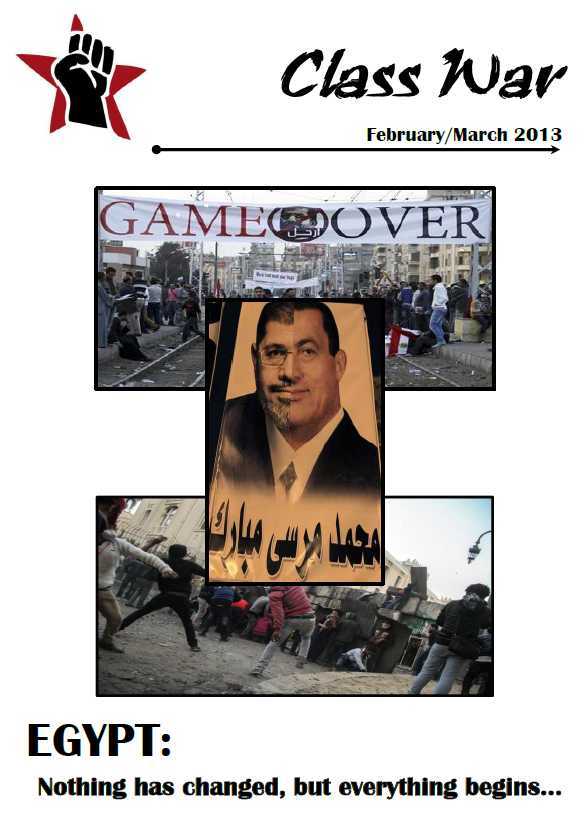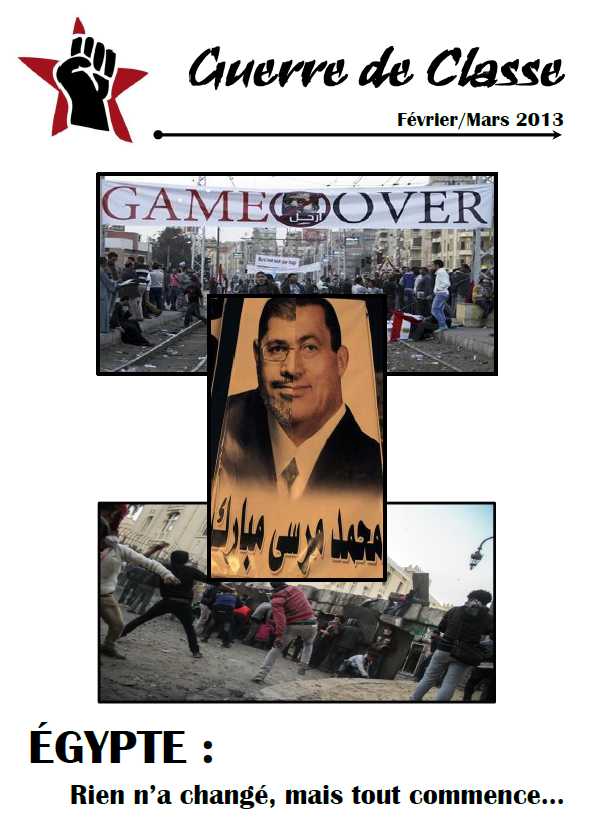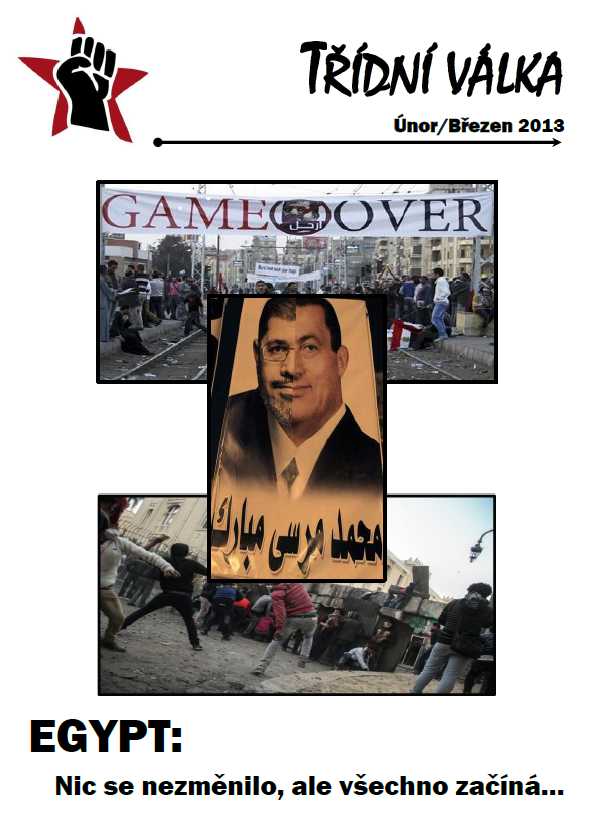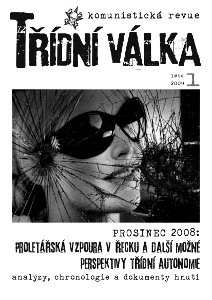| English | Čeština | Français | PDF |
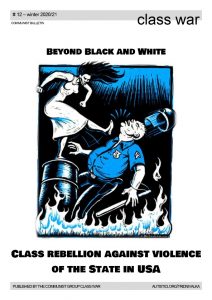 Beyond Black and White – Class rebellion against violence of the State in USA
Beyond Black and White – Class rebellion against violence of the State in USA
It was May 25, 2020, police in Minneapolis, Minnesota had murdered George Floyd and thus provided the spark that started the largest proletarian movement in USA since late sixties. Movement that soon spread from the burning streets of Minneapolis to more than 2,000 cities and towns across the USA with as much as 26 million of participants and with ripple effects in many countries around the world, where the expressions of proletarian solidarity with the movement in USA organically merged with rage against local forms of misery that life in capitalist society brings.
And yes, let us stress right from the start the proletarian nature of this movement against all attempts to falsify it as “race riots” or as a reformist partisan movement controlled by the Democratic Party or by George Soros.
This movement is not the first massive explosion of rage against murderous violence that repressive forces of the global capitalist State in the territory of USA commit against “their” proletarians. Repressive forces that disproportionately target the proletarians that are racially “black” or “brown”. In fact, murders of young “black” proles by pigs in uniform recently provoked at least two major waves of unrest (weeks of riots and looting in Ferguson and St. Louis area in 2014 as well as in Baltimore area in 2015 plus related solidarity actions in other cities).
It is however unprecedented in many ways – reality of piles of black body bags of victims of Covid-19 (or plenty of other health issues, that overwhelmed hospitals could not handle), debilitating alienation of quarantine, sky-rocketing unemployment, new cynical multi-trillion “stimulus package” bringing funds for the bourgeoisie and pittance for the proles. All this added to years of police brutality created an explosive mixture that was set off by murder of George Floyd recording that spread online. And when it finally exploded, it included everybody. For the first time since a long period, all the separations based on the race imposed on our class by bourgeois society in the territory of USA had been seriously shaken.
In Minneapolis, “white” proles joined their “black” class brothers and sisters in a violent battle with the police. Together they torched the Minneapolis Police 3rd Precinct to the ground, together they cracked heads of some cops and together they expropriated commodities and destroyed the “sacred businesses”. The Minneapolis bus drivers had also given the pigs a giant middle finger, when they refused to transport the arrested protesters. But let’s hear the account of our class enemies – bourgeois media and relish in their panic, shall we? Here is (a Minneapolis newspaper) Star Tribune:
“In the first few days after George Floyd was killed by Minneapolis police, rioters tore through dense stretches of Minneapolis, St. Paul and other metro communities in retaliation, causing millions in property damage to more than 1,500 locations.
In their wake, vandals left a trail of smashed doors and windows, covered hundreds of boarded-up businesses with graffiti and set fire to nearly 150 buildings, with dozens burned to the ground. Pharmacies, groceries, liquor stores, tobacco shops and cell phone stores were ransacked, losing thousands of dollars in stolen merchandise. Many were looted repeatedly over consecutive nights.
Other property — like gas stations, restaurants and even parked cars — was set on fire, with much of it completely destroyed.”
Bourgeois media across the US and the world will later repeat some similar version of this fearful recite– and with good reason!
As the movement rapidly spread to other cities and regions, the militant focus persisted. Buildings that were attacked included CNN headquarters in Atlanta which also houses a police precinct of the Atlanta Police Department, many bank branches, down-town shopping alleys, restaurants, town halls and even private mansions of mayors and governors. Police cars were smashed and burned systematically. The choice of the targets once again confirms the class nature of this upheaval: focusing on infrastructure of the State, symbols of capitalist accumulation, sources of commodities to loot and redistribute between comrades as well as bringing the struggle to the “private sphere” of representatives of the bourgeois State. The choice of the targets also draws parallels with current or previous class movements in other parts of the world – in Iraq, Lebanon, Egypt, Greece, Chile, France, etc. And all around the world a wave of unrest has arisen in solidarity with the movement in US, as well as attacking the racist bourgeois separations at home – in France, UK, Brazil, Canada, Australia, New Zealand, Mexico…
As the movement spread to other cities, it brought forward the matter of other racist police murders, as well as other issues like resistance against foreclosures and evictions, gentrification of the cities, struggle of medical workers and other “essential workers” during Covid-19 pandemic, etc.
We should also add that even though the movement reached limited insurrectionary qualities in its most militant expressions – directly attacking the infrastructure of State power, expropriating and organically redistributing commodities, grasping the question of arms, etc. – it nevertheless as a whole remained locked in its initial premise of street protest against police brutality towards “black” proles in particular (“non-black” victims of police violence rarely get mentioned) and confrontation with well-prepared police. We have seen and criticized similar limits many times during other recent expressions of the class movement like “Yellow Vests” protests, Hong-Kong movement, etc. What we see as one of the common aspects of these movements is the apparent contradiction between their confrontational militant continuity (which we in fact consider to be one of their strengths) and the lack of any programmatic and strategic breakthrough or qualitative leap.
As in other class movements of such intensity, we see the emergence of affinity groups that are able to come forward with the organization of important practical tasks like logistics of the protests, food distribution, planning of attacks on the forces of repression, organization of armed defense, etc. There is also a visible wave of fresh energy brought by this movement to the pre-existing revolutionary structures that are trying to comprehend the dynamics of the movement, to participate and to give the programmatic direction to it.
It remains to be seen what programmatic, tactical and organizational lessons will be drawn from this interaction. Let us reiterate that we do not believe in any magical appearance of the “finished” revolutionary communist structures from the middle of any proletarian protest movement, ready to lead the attack on the totality of global capitalist society in dialectical unity of tactical and programmatic means. It has historically always been rather a product from a process of sharing experiences of the struggle, discussions and organizational ruptures taking place inside and outside both pre-existing and ad-hoc militant structures.
Anti-racism – the Worst product of Racism
Of course as always, the forces of social-democracy – the bourgeois organization for proletarians – called into battle. Army of liberal and leftist pacifists – including the official Black Lives Matter organization – came to calm down and appease the protesters and turn the movement into yet another impotent charade. They got immediately to work in order to mask the class nature of the movement, to stress inter-class “Black solidarity”, to silence class militants and denounce them to police. At the same time “black nationalists” like Nation of Islam, New Black Panther Party and especially NFAC (Not Fucking Around Coalition) militia are trying to dominate the movement, spin it as “black versus white” issue and co-opt and militarize under their own leadership its organically developed armed expressions.
In order to steal some credibility for themselves, they have enlisted a plethora of veterans from the so-called “Civil Rights Movement” and from Ferguson movement – using age-old tactic of the historical social-democracy of parading behind recuperated, toothless, past militants.
The result was that until the resurgence of confrontational tactic after pigs crippled Jacob Blake in Kenosha, Wisconsin, the militant face of the movement had been pretty much limited to several locations like Seattle, Portland and Chicago, while majority of the movement had been channeled into tiring marches to nowhere, endless speeches of NGO activists and artistic expressions of positive identities. These social democrats also successfully managed to exploit and to weaponize the weaknesses present in the movement: the racial identity and internalized ideology of “white guilt”. From the numerous accounts of comrades involved in the movement, it is common on the public assemblies of the movement, that the most reformist asshole speakers, if they happen to be “black”, are able to silence the radical critique, if it happens to come from a “white” person.
According to these comrades, there is also a level of distrust of the “outsiders”. In the context of this movement, the racial aspect of course plays a role in who is considered an “outsider”. Partially it is because of the propagandist story – invented by bourgeois media and parroted by leftists – according to which destruction of private property and looting of commodities (practical expressions of class subjectivity as well as necessity in any proletarian struggle) are in fact responsibility of “white supremacist” groups.
It is true that some of the “accelerationist” far-right groups tried to use the protests to escalate the armed confrontation, either by attacking the protesters or by mingling with them and shooting at cops. According to the ideology of these reactionary dreamers, this will provoke even more violent response from the government and also discredit the movement in the eyes of the so-called “silent majority” (majority of “white” people) – which they assume to be inherently racist and conservative. This should serve as a spark to start a new civil war.
This relatively fringe far-right adventurism has been blown out of proportion by the left and in “the best tradition” of united anti-fascist front used to denounce any expression of practical class critique of capitalist social reality as a fascist provocation. The same strategy is used for example by “Bolibourgeoisie” in Venezuela (and their allies worldwide) that accuses the proletarians taking part in strikes, fighting against cops and army units, looting, etc. of belonging to supporters of Juan Guaido’s “neoliberal” clique.
We could see practical impact of this ideological massage on the ground, when militants who overstepped the democratic boundaries set up by vigilantes of “black” counter-insurgency groups were exposed to or even handed over to police by them and nobody stepped forward to protect them. If they also happened to be “white”, this was justified as exposing “white supremacist infiltrators”.
There is also a theory, implicitly accepted by a big part of this movement that the revolutionary subject here is “the Black people” or “the Black proletariat” whose revolutionary program is the abolition of “racial capitalism” and the role for “whites” is reduced to “allies” – to “support the Black struggle”. But in reality there is only one global capitalism, regardless of any superficial formal characteristics it may take in USA or some other region, and the only way to abolish it is through the revolutionary action of unified global proletariat. All sectionalism based on sociological characteristics like “race”, “ethnicity”, “gender”, “nationality”, “sexuality”, etc., leads only to division of our class forces and it allows social-democracy to co-opt and channel the movement towards reformism and inter-class collaboration. The “white” proletarian militants have to revolt primarily against their own misery of life in capitalist reality, against exploitation and alienation, against the violence of the State that kills them, while at the same time – organically and inseparably – practice the real militant internationalist solidarity with proletarians of other “races” (as opposed to mere show – spectacle – of solidarity requested by reformists).
On another level, “outside agitator” is an age-old ideological construct drawing its force from a lack of class consciousness (proletariat as a class united by the same interests regardless where and how individual proletarians live or work) and internationalism in the proletariat. Counter-revolutionary forces use it and take profit of it in order to break the emergence of proletarian associationism, to target the militant minorities – trying to give direction to the struggle, to clarify the targets and organize the insurrectionary tasks. Let us stress here that communists totally refuse all bourgeois constructs claiming existence of militant minority as entity separate from the class, both in a negative sense of “agitator” mentioned above and in positive Leninist sense of a cadre of “revolutionary experts”, bringing “the political conscience to the proletarian masses”. Communists do not have any goals different from the historical goals of the rest of the class – abolishment of the class society based on the exploitation of human labor and creation of global classless human community!
To fully understand the specifically American racial aspect of the global bourgeois divide and conquer strategy, we need to do a quick simplified overview of its historical roots. As is generally known, the European colonization of the Americas stood on roughly three massive population shifts. First, relatively small number of well-armed European conquistadors and settlers had depopulated the land of natives through disease and violence. Simultaneously, Africans had been captured, sold and transported to Americas to provide slave labor to plantations of cash crops like cotton, tobacco and sugar. Such a brutal terror of course didn’t go without resistance and violent slave rebellions. Of these, the best known is of course “The Haitian Revolution”, but there were other significant uprisings – in Northeast Brazil, in the US South, in Trinidad…
With the development of Capitalism and spread of capitalist social relations through so-called “Industrial Revolution” into the territory of today’s USA (and Americas in general), wage labor – that could be fired and hired freely by the capitalist – became more and more dominant form of extracting the value. This was intertwined with the last massive population change in Americas – a massive immigration wave from Europe; the peasants dispossessed of their land by the primitive accumulation of Capital (e.g. enclosures of Ireland and Scotland or land reform in Austrian Galicia) or the workers suddenly representing a surplus labor due to a crisis in the pole of accumulation of Capital (e.g. exodus from Naples after the Italian unification). Only in tropical regions, like the US South, with multiple harvests a year could economic system based on owning the slaves continue to be competitive. In US North this served as a material basis for legally abolishing slavery altogether.
Emerging victorious from the Civil War, and pushed by the Abolitionist militancy, northern faction of Capital got rid of the anachronism of southern slavery and in the process proletarized the “black” ex-slaves and liberated the labor of part of them for the needs of booming northern industry.
The Southern economy remained dependent on cotton production which in turn remained dependent on the labor of ex-slaves, who had been freed without any money or land and had no other chance than to continue working for their former slavers or to emigrate. It was also crucial for the Southern ruling class to prevent the class solidarity between “black” and “white” proletarians – exploiting and consolidating existing divisions inside our class had always been one of the primary weapons of the bourgeoisie against us. The system of debt servitude and “vagrancy” laws had been created to keep “black” ex-slaves bound to the plantation. At the same time a system of race based separation and hierarchy inside of our class was created and has been socially reproduced since.
Subsequently, an important part of the mechanism integrating a “white” proletarian into the bourgeois democratic project, into the participation in management of his or her own misery and exploitation has been the fact that his “black” fellow was screwed more, living in worse conditions and suffering worse repression of the State. This allowed the racially “white” section of the workforce to internalize the ideology of white superiority and undermine potential for class solidarity across the race lines.
With the post-WW2 “economic conjuncture” came “The American Dream”, becoming the most successful and prolific version of the ideology fabricating existence of “the middle class”. Ideology replicated since then all around the world, in order to falsify and cover the essential antagonistic relation of the capitalist society, i.e. a class conflict between proletariat and bourgeoisie. The ideology of the middle class mixes together lower strata of the bourgeoisie – small owners, with a strata of highly qualified and “creative” workers and lower tiers of management and State bureaucracy. In exchange for their pacifism and loyalty to the bourgeois order they are rewarded with “a social status”. In reality of USA this ideological construct had an additional crucial quality – whiteness. Every “hard-working (indeed due to widespread adoption of piece-work and lot of patriotic propaganda, USA managed to create its own equivalent of Stakhanovite movement), obedient and WHITE worker” could dream about reaching this status and associated status symbol commodities like a suburban house, personal car, etc. Needless to say that it was made possible also through the post-WW2 appearance of cheap and widely available credit, as wages alone usually weren’t enough to allow this.
The so-called “Civil Rights Movement” that started as a reaction against daily oppression, horrible living conditions of “black” proletarians and violence of the State – which in itself formed a part of larger wave of class struggle in US and globally – challenged this setup. To once again channel the subversive activity of the struggling proletariat and pacify its rage, social-democracy in USA had to reshuffle the cards and try to integrate “blacks” into the bourgeois social contract. This gave birth to a variety of professional black activists: “civil rights leaders”, “black-led” Trotskyist and Maoist groups, politically involved “black” church groups, Nation of Islam, etc. These in turn became a base for nowadays “black” NGOs and “black radical academics” and “radical artists” tasked by the State with managing distribution of breadcrumbs from bourgeois table for “black” proletarians and poisoning them with positive racial identity in order to (in tandem with “white” racist groups) divide our class along racial lines.
In essence, racial separation in USA serves the same purpose of mobilizing proletarians to defend the interests of their “own” faction of bourgeoisie as nationalism globally does. The specific advantage (for our class enemy of course) of American system of racial division is maintaining clear hierarchy between “black” and “white” proletarians. No wonder that this has been historically reflected in natural international political alignment of “white supremacists” with reactionary movements nostalgic for their nation’s “imperial greatness” and “black nationalists” with “anti-imperialist” and “national liberation” front.
So, back in 2020 we can see this tandem – opposing each other formally on the ideological level – at work once again, busy trying to channel and assist in the State repression of the largest militant proletarian movement in the territory of USA in last fifty years and trying to prevent or kill any possible convergence with other struggles. This ideological false choice has been of course fully utilized by the opposing multi-billion propagandist machines of the Republican and Democratic Party and their associated media. Unfortunately, this was rather effective and by November 2020, most of the movement had been co-opted into anti-Trumpism/anti-Fascism.
Beyond Black and White: Red flame of global proletarian insurrection
Not all is lost however. Despite the brutal repression of the State and partisan channeling of the movement’s energy into support for Democrats in electoral politics, its militant proletarian current managed to regroup itself and to find new expressions. It is shown for example by continuation of street protests denouncing both political parties and their leaders, as well as the concept of bourgeois politics as such, and often culminating in attacks on property of both parties.
The reality of the economic crisis, exposed and boosted by the effects of pandemic, led to a large number of evictions and home repossessions by the banks all around the USA. This created a movement of proletarian resistance – squatting and occupations of homes, of public building, of land; confrontation with police and with utility companies coming to cut the services; occupations or ransacking of town halls and housing association buildings; creation of support networks to distribute the food, fuel and medical supplies. Wildcat strikes swept through Amazon and delivery companies deemed “essential”, that forced their workers to extreme levels of exploitation in order to deliver the goods as well as exposing them to Covid-19 without protection. Mutinies and strikes hit also the prison-industrial complex. Resistance to deportations of immigrant families and to ICE (U.S. Immigration and Customs Enforcement – agency responsible for running the immigrant detention centers) also continues. All these struggles against other faces of dictatorship of Capital in the territory of USA always existed in the background, partially overshadowed by the bright light of the movement against most direct aspects of brutality of the State. Now these movements are coming more to the forefront of the class battlefield in USA and militant links are connecting the most radical elements of all these struggles together giving birth to a real community of struggle!
The social contradictions that gave birth to this wave of struggle are not going to disappear – in fact they are inherent to Capitalism. As we have pointed out in our text “Class struggle in times of Plague Inc.”, the deep structural crisis of valorization of Capital that has been exposed by the Covid-19 pandemic cannot be easily resolved by the measures that had been adopted by the bourgeoisie in the past. It will try to resolve it; however in only way it knows – by repeating again the cycle of exploitation. This will inevitably bring more misery and alienation to the proletariat, more attempts by the State to pit us against each other, more State surveillance and police violence – more murdered “black”, “brown” and “white” proletarians, more diseases and incoming climate catastrophe.
As communists, we want to point out what we see as crucial for generalization of the upcoming wave of the proletarian class struggle in the territory of USA and globally, deepening of its ruptures with the capitalist society and clarification of its direction towards the global human community. All these are not some ideals dreamed-up by “experts in revolutionary theory”, but the most advanced elements of negation of Capital and its State, however minoritarian, that we can recognize in the proletarian movement in USA of today. We also recognize it as our task to strengthen and clarify these expressions of the historical communist movement against the attempts of the historical social-democracy to channel them into bourgeois anti-racism, election support, police reforms, etc.
We support and claim as a part of the revolutionary project of our class:
- The coordinated and systematic attacks on police stations, town halls, media HQ’s, houses of the politicians…
- Conscious and direct practical abolition of social separations along racial lines – “black” and “brown” and “white” proles fighting, risking their lives together, discussing, sharing…
- Rejection of the bourgeois politics with its elections, parties, trade unions, NGOs…
- Assuming the question of armed violence in order to defend the movement against State violence (governmental and para-military alike) and in order to attack the representatives of the bourgeois order…
- Direct internationalization of the struggle – sharing experience, coordination, expressing solidarity with the struggles in Mexico, in Europe, in Nigeria, in Hong Kong…
Let’s organize ourselves as a class to overcome all the bourgeois falsifications and separations imposed on us, to oppose the State violence and to destroy the Capitalist society based on the exploitation of human labor!
# Class War – Winter 2020/21 #
Appendix
Lastly, here we would like to bring the attention to the text “The Rise of Black Counter-Insurgency” written by “Ill Will Editions”, that we publish together with this text.
As the title suggests, it comes with an in-depth analysis of the specific variation of the historical social-democracy with Black identity that developed in the territory of USA as a response of the State to proletarian movements of the past abolishing racial categories and hierarchy central to the system that keeps local proletariat divided along race lines.
However, there are a couple of critical points that we would like to make to this otherwise very strong text.
As communists, we totally oppose the use of the dangerous bourgeois concept of “the middle class”.
This bourgeois ideology serves once again to hide the nature of the class antagonism between two classes with opposing historical interests, stemming from the very essence of the capitalist mode of production; exploitation of the working class (proletariat) by the class of owners of means of production (bourgeoisie). Let us briefly describe the material roots of ideology of “the middle class” and its role in capitalist society.
As the development of Capital brings also the development of means of production, tools and machines used by workers become increasingly trivial to operate, but at the cost of becoming internally more and more complex and fragile systems. At the same time, racing against general tendency of rate of profit to fall, in order to conquer new markets, individual capitalist factions as well as capital as a whole, have to absorb and turn into a commodity always increasing share of social life of proletariat (interpersonal relations, “leisure time”, “culture”, etc.) – as territorial expansion is no longer possible in globally capitalist society.
All this creates a need for Capital of highly skilled and educated proletarians to design, develop, maintain and repair means of production (technicians, engineers), to develop skills, but also ensure subjugation to dominant class ideology, of other proletarians (university teachers, corporate trainers), to help shoving the goods down the throats of potential buyers (marketing and financial specialists), to help with organization and commodification of reproduction of labor power, dealing with laws and property (psychologists, lawyers, architects, artists, etc.).
These and many other professions are usually better paid and require from the worker not only certain level of skills and knowledge, but also some degree of creativity and responsibility. In order to be effectively performed, a work of let’s say fashion designer or psychologist needs certainly more internalization, than a work of assembly line or foundry worker or bartender. This illusion of human activity – when they are forced to sacrifice their human creative power to discuss, to plan, to take decisions, all that as a part of the capitalist productive process – make these workers identify with both the productive process and the product itself and helps to conceal from them the reality of their alienation from means of production. These conditions (usually higher standard of living in comparison with the rest of the proletariat and an illusion of control over their own lives via participation on decision making in process of production) lead them to a false consciousness of their exclusivity and form basis of the bourgeois ideology of middle class.
We would therefore like to call here to the comrades not to use this bourgeois category created by our enemies only to confuse our class and to divide our struggle.
Our second objection is to the use of the concept of “racial capitalism” throughout the text. We understand what the comrades are referring to – a system of deep structural racial division and hierarchy with roots in the history of genocide of indigenous population and enslavement of Africans that permeates a whole economic, social and political reality of life in USA (and Americas). We also understand that comrades from “Ill Will Editions” use this concept to criticize “Black” social-democracy for trying to simply correct these racial aspects in favor of what the comrades call “simple capitalism”.
For us, however this concept is not useful at all and on the contrary it contributes to the confusion of terms. There is only one global capitalism, regardless of the specific aspects of the form in which it organizes its functioning. Therefore, we do not call the “Soviet Bloc” the “State Capitalism”, even though its faction of the bourgeoisie was organized into a political party (falsely pretending to be the Communist Party) or because the private property was masqueraded as “property of the people”; we do not call YPG regime in Rojava or CNT regime in Spain of 1936 “self-management Capitalism”, even though they hide behind anarchist flag and organize their State structures in cooperative and “directly democratic” manner. They represent just different State organizational forms serving the enforcement of the same fundamental capitalist process of exploitation.
Similar social reality, of entrenched racial inequalities, particularly historically rooted in enslavement of a specific “ethnic group” is not unique to USA (or Americas). We can take as an example “Roma” ethnic group in Eastern Europe that had been similarly historically enslaved (and subjected to physical and social separation from the rest of society, subjected to restrictions on certain jobs and on land ownership, subjected to pogroms and finally genocide) and they are still at the bottom of racially defined social hierarchy. Another example of the same is a social hierarchy between more “Arabized” mixed population of the Sahel countries like Mali, Mauretania, Sudan – and their former “black” slaves. In other forms, a separation and hierarchy along the racial or national categories is a global reality.
As comrades from the Internationalist Communist Group (ICG) had put it in their “Thesis of Programmatical Orientation” no. 39A:
“… The fact that Capital buys the labor power of one race for less than another’s, the fact that the conditions of exploitation and the living conditions of one part of the proletariat are worse than another’s, reflect that in Capital’s reality a human being’s production, as a wage slave, is of absolutely no interest as a human being, but is solely determined (as with all other commodities) by the amount of social labor incorporated into him. This racist reality of Capital determines that, in the same way that the value of labor power of a qualified worker is greater than that of an ordinary worker, the value of the labor power of a “native” worker, for example, is greater than that of an “immigrant” worker (presupposing that the former contains more work of integration, socialization, nationalization and unionization than the other)…”
Despite these critical points we made, we consider this text as an important part of the global militant effort to understand the strengths and weaknesses of the proletarian movement in the USA, to clarify its class nature against bourgeois falsifications and to denounce the activities and ideology of its most dangerous enemies – its false “Black friends”!
The Rise of Black Counter-Insurgency
Shemon, July 30, 2020
Introduction
From May 26 to June 1, 2020, a Black led multi-racial proletarian rebellion burned down police stations, destroyed cop cars, attacked police, redistributed goods, and took revenge for the murder of countless Black and non-Black people by the police. By the first week of June, everything seemed to have changed, everyone seemed to have forgotten that any of this happened, and instead we became good protestors, we became non-violent, and we became reformists. Instead of attacking police, we endured countless marches with no point other than to continue marching. From revolutionary abolitionists, we became reformist abolitionists. What happened?
There are many easy answers, all of them incorrect. One potential answer would point to the police repression of the movement, which resulted in over 14,000 people being arrested. Another would point to the white people who joined the movement, and who brought with them all their liberal politics and strategies. Finally, the most ridiculous answer of all maintains that the militant phase of the rebellion was never a real movement of Black and non-Black proletarians to begin with, but was in fact a product of outside agitators.
In reality, something much more dangerous and sinister took place, something organic to racial capitalism, and with roots extending back to the African slave trade and the Haitian Revolution. A counter-insurgency campaign has fundamentally altered the course of the movement. While the retreat and defeat of the movement that it induced may turn out to be temporary, such campaigns present significant obstacles to further radicalization, and therefore must be addressed. This counter-insurgency campaign on the ground was spearheaded by the Black middle class, Black politicians, Black radical academics, and Black NGOs. This may come as a shock to people whose impulse is to think of Black people as a monolithic political group. This conception is false.
This was not a local phenomenon in one or two cities, but a dynamic that has taken place across the United States. A widespread rebellion demanded a widespread counter-insurgency. And while there is no doubt that behind the Black-led counter-insurgency lie billion-dollar philanthropies, universities, the state, and the white middle class, the uncomfortable truth is that a Black-led rebellion could only be crushed by a Black-led counter-insurgency program. None of this could have taken place if there were not a significant layer of Black counter-insurgents across the United States.
The rise of the Black middle class is an organic development of class stratification under racial capitalism. It is the starting point for understanding the counter-insurgency that is presently strangling the George Floyd Rebellion. The latter has its social basis in the Black middle class, who seek at most a narrow reform of the system, namely, the transformation of racial capitalism into simple capitalism.
In the long run, the Black middle class is the enemy of the Black proletariat: the unemployed, waged workers, sex workers, etc. The true partners or accomplices of the Black proletariat are the Latinx and white proletarians, Indigenous peoples of Turtle Island and the international proletariat. So far, few in this country seem to have figured this out, let alone what political and strategic implications follow from it. Although none of these problems are new, it is worth returning to them once again.
The Black Middle Class
There has always been a tension in the struggle for Black liberation over the question of the Black middle class: doctors, lawyers, professors, managers, and business owners. Not over its existence, but over its political role and behavior in the struggle against white supremacy.
In many ways, the Black middle class is no different from other middle classes. At their core, all middle class politics are electoral, legislative, and reformist. Their strategies are about respectability, the protection of private property, and ultimately about following the law. Middle classes have always felt entitled to speak for and represent their respective proletariats. They advocate for multi-racial unity amongst their class peers, at the same time as they use racial loyalty to advance their own positions under racial capitalism. All middle class analysis sees the proletariat as its threat or victim; none see the proletariat as a revolutionary class. Those few middle class people who see the proletariat as revolutionary either work to repress the latter, or else wind up joining them in struggle.
In 1931, W.E.B. Du Bois argued that so long as Jim Crow limited the Black middle class’s opportunities, the Black proletariat and the Black middle class needed to fight together against white supremacy. By the 1960’s, however, the Black Panther Party and the League of Revolutionary Black Workers were already convinced that the Black middle class and Black proletariat had parted company. With the defeat of Jim Crow in the 1960s, middle class Black people found a path to success, resulting in vast differences between themselves and their dispossessed neighbors.
The movement to defeat Jim Crow did not destroy racial capitalism or anti-Blackness; rather, while it opened up new avenues for a small handful of Black people, their victory at the same time become a devastating defeat for the masses of Black proletarians who remain stuck in their miserable conditions, with the sole difference that their workplaces and neighborhoods are now managed and policed by the ‘victorious’ Black middle class. In this respect, the Black middle class is not entirely lying when it casts itself as the culmination of the Civil Rights Movement and Black Power. These contradictions existed prior to the movements of the 1960’s, and they have never been clarified on a mass level ever since. The Black middle class has been, and remains to this day, the contradiction of the Black Liberation Movement.
The essential difference between the Black middle class and the white middle class is strategic: the Black middle class uses Black proletarian struggles to advance its own cause. Since it is not strong enough to advance its cause on its own, it leverages the fear of riots and street protests to push its own agenda. The Black middle class cannot completely dissociate itself from the militant phase of the rebellion because it needs to wield riots and violence as a potential threat over the rest of society. At the same time, the Black middle class cannot identify itself with the riot, because to do so would contradict its own desire to be integrated into the capitalist state, whose laws and order secure the existence of private property.
The result is a confused and contradictory relation marked by a triple dynamic: (i) the Black middle class strives to achieve the wealth and power of the white middle class, (ii) yet this requires it be willing to discipline the Black proletariat, (iii) with whom it nonetheless shares a sense of linked fate driven by the police’s and other white people’s inability to distinguish poor Black people from the hood from their suburban counterparts. This threefold dynamic finds expression in the general thrust of mainstream Black Lives Matter protests, whose middle class activists advocate simultaneously (i) for police to stop confusing the Black middle class with Black people from the hood, (ii) for the state to spend more money on social reproduction in the hopes of catapulting more Black people into the Black middle class, and (iii) to create more positions for the Black middle class in universities, corporate board rooms, etc.
All of Black middle class society is poised to gain from the efforts of Black proletarians. In the coming months, the victories won from the rebellion will come in the form of the new and worthless ‘diversity’ positions, pointless academic conferences and articles, and pitiful salary bumps. For now, the current protests must maintain their parasitic relationship with the initial George Floyd Rebellion. Following the militant phase of the rebellion, protests have gone into a zombie-like phase of endless marches, often through already empty streets and highways. It is as if police stations were never sieged, smashed, and burned down. Protest after protest happens, without a meaningful reflection upon what took place that first week. Whereas 2014 introduced highway blockades to the tactical repertoire of anti-police struggle, we might have thought “burnt precincts” would be remembered as Minneapolis’ contribution. Instead, the advances made in Minneapolis are being buried under the street marches across the country, as Black leadership reinforces reactionary divisions between peaceful and good protestors [and bad rioters].
Revolutionary versus reformist abolition
There are two kinds of abolition: revolutionary abolition and reformist abolition. Revolutionary abolition is the self-activity of the proletariat in fighting against the entire carceral logic of the state and racial capitalism. This includes burning down police stations, destroying cop cars, attacking police officers, and redistributing goods from Target and Versace. Revolutionary abolitionism stands in alliance with revolutionary anti-capitalism, since it grasps that abolition is only possible when tied to anti-capitalism, anti-statism, anti-imperialism, anti-homophobia, and anti-patriarchy. Prisons have to be abolished, but so do schools, social workers, and the army of middle-class institutions and do gooders. The expansive dynamism that it names therefore cannot stop with the police, but must extend its attack to the wall separating the so-called United States and Mexico, to detention centers, to courts, and the vast infrastructure of the carceral state and capitalism.
Revolutionary abolitionism quickly reached a boiling point during the first week of the rebellion, with a resurgence again this past week on July 25th. In the interim, revolutionary abolition was largely displaced by a reformist abolition, a current largely defined by the activity and politics of professional activists, NGOs, lawyers, and politicians, and concerned primarily with ‘defunding’, policy, and legislative shifts. This perspective continues to see politicians as the principal historical actors, in relation to whom it positions itself as a pressure group. In this way, reformist abolitionism removes proletarians from the terrain of struggle.
While it is correct to observe the gross injustice of police budgets by contrast with expenditures on health, infrastructure, school and other services, proposals to ‘defund’ amount to little more than a monetary displacement from one portion of the state to another. Moreover, even when reformist abolitionism begins to imagine abolishing the police, as is the case right now in Minneapolis, it cannot seem to grasp that the police cannot be abolished by legislation. What the reformist abolitionism fails to see is that it has always and only ever been actual or feared revolutionary wars that abolished slavery. The shortest path to dismantling police and prisons is and has always been through revolt, as we saw last year when the uprising in Haiti led to entire prisons being emptied. Insurrection forms the centerpiece of revolutionary abolition.
In light of revolutionary abolition surfacing in the country with attacks on DHS offices in Atlanta and the burning of courthouses, reformist abolition is a direct attack on these more militant means of abolition. Nowhere has this tension and relationship between reformist abolition and revolutionary abolition been more fraught than in Minneapolis. Reformists had been preparing for years in Minneapolis and the rebellion provided them with the leverage to make their move. What began as an all-out assault on the forces of law and order in Minneapolis has since been transformed into a plethora of anodyne political projects. As the Black proletariat recedes, the Black professional activist comes to the front, until all is good and holy again.
NGOs and academics
Black non-governmental organizations (NGOs), including the groups in the Movement for Black Lives, have played a key role in this counterinsurgency campaign. Their social base is not the Black proletariat, but the Black middle class and – most importantly – the white bourgeoisie, through the mediation of philanthropies. In order to co-opt the movement, the bourgeoisie is throwing money at problems generated by racial capitalism. In the NGO, they have found a willing group of people who will happily accept their dollars. Money is falling from the sky: if you are Black, middle class, and can say Black Lives Matter three times, money will magically appear in your lap. While these NGOs vary politically, they tend to have little or no background in struggle, no particular concern for movements, and ultimately no interest in overthrowing racial capitalism. They are merely a reflection of the various parasites sucking the blood from the historic struggle of Black proletarians. They solve nothing in the long run, and it is unlikely any of them will actually lead the movement, since they have no base. However, because the movement generated by the George Floyd Rebellion is new, many of its participants are still easily confused, and thus continue to display a servile willingness to follow any Black person that shows up with a megaphone. While it is inevitable that some NGO activists will once again split away from their groups and join the more radical elements in the movement, any strategic orientation that centers their potential energy is mistaken. Waiting around for the radicalization of the NGOs is like waiting around for unions to radicalize. Somehow, NGOs must eventually be kicked out of the movement.
And what of the so-called “revolutionary Black intellectuals.” Since the word “revolutionary” is meaningless in non-revolutionary times, and the restricted practice of being an “intellectual” is rendered inoperative during revolutionary times, we’re dealing with a contradiction in terms. Whereas in non-revolutionary times the activities of academic intellectuals reflect the standard capitalist division of labor between the thinkers and manual workers, in insurrectional moments the division of labor tends to collapse and be rearranged, such that many proletarians suddenly find themselves engaged in forms of reading, writing, and theorizing that had previously been the exclusive task of intellectuals.
Let it be said clearly: the George Floyd Rebellion is the new criterion to which all theories and politics must be held to account. Not to tenure demands, not to academic journals, not to a community of so-called scholars, but the fire and heat of the proletarian struggle. They must answer to the demands of riots, strikes, occupations, blockades, insurrections, war, and revolution. And in this regard, it must be admitted that the results have so far been a disaster. Black Marxism, Afro-pessimism, Black Anarchism, and Black Feminism have all been put to the test in this uprising, and all have failed. These theories have had little to no meaningful impact on the Black proletariat. In certain cases, they have even enhanced their careers by lending their voice to counter-insurgent NGOs who are only too happy to pay an honorarium.
What happened to Black Revolutionary theory? For over fifty years, theories have been hiding in the academy. The university has completely commodified Black radical thought, which has divorced it from Black proletarians by determining who has access to it and who is able make sense of its dense and obtuse language. The issues and questions that matter to the Black proletarian are never addressed on the terms, concepts, and traditions of the Black proletariat, but instead are discussed on the much narrower and reformist terms of the academy. No idea in the academy is accountable to the Black proletariat, against whom a tenured job offers the radical academic the ultimate insulation. This lack of accountability protects outdated and useless ideas, allowing dusty old theories that were long ago defeated in the actual class struggle to continue to live on in the academy, becoming a dead weight on the movement’s brain.
This stops now. The full force of a rebellion has cleared the debris in a manner that critique could never accomplish. Although the political consolidation of the rebellion has fallen to the Black counter-insurgents for now, the George Floyd Rebellion has allowed the next generation of Black revolutionaries from the proletariat, as well as and some renegade middle class people, to emerge and catch sight of itself. In the upcoming months and years, we must do what we can to help them unburden themselves of the false divisions of intellectual activity and revolutionary activity that have long plagued our movements.
Conclusion
If capitalism is ever to be abolished, if a liberatory communist future will ever see the light of day, the proletariat must emancipate itself by force from its dependency on the bourgeois social order. But before the antagonism can reach this point, another battle must also take place, in which the Black proletariat politically and materially settles its accounts with the Black middle class. This is not a new reality but one with which every revolution involving Black people has had to wrestle. So far the Black proletariat has lost every one of these struggles, resulting in a capitalism and state with a Black face.
If the Black middle class has been able to wage the counter-insurgency so effectively, this is in part due to the fact that it has captured key parts of the state. Lori Lightfoot in Chicago, Keisha Lance Bottoms in Atlanta, Chokwe Antar Lumumba in Jackson, and Bernard Young in Baltimore offer just a few examples of an aspirational managerial tier that is conscious of its class interests in a manner that the Black proletariat has yet to figure out. They attend the best schools in the country, allowing them to mobilize the kind of cynical arguments that are needed to articulate a reformist and counter insurgent program.
The middle classes have their universities, elections, corporations, and other institutions to develop their version of the rainbow coalition. The proletariat is left outside of the process.
The Black proletariat can lead and spark the struggle, but will win no decisive battles without accomplices in the white and Latinx proletariat, and Indigenous nations. As it cleaned out as many stores as it could, the Black proletariat fought together with other proletarians. For one week, an organic alliance was built, as different oppressed groups rained fire on police and redistributed goods across Turtle Island.
However, these organic alliances do not automatically lead to more permanent alliances. The gigantic eruptions of solidarity in riots and uprisings tend to quickly retreat back into antagonistic relations amongst proletarians soon after. After all, sharing a moment of combat is not the same as forging long-term trust and solidarity. What is more real, one week of shared unity or a life-time of proletarian conflict with one another?
The Black proletariat faces job competition, housing competition, and the struggle for other scarce resources against other proletarians. The respective middle classes promise to secure these goodies as long as Black proletarians continue to vote for Black politicians, Latinx proletarians vote for Latinx politicians, and so on. Although this logic is a dead end for proletarian multi-racial solidarity, it serves short term aims that are often difficult to ignore for dispossessed folks. In this way, the fragile unity forged in moments of revolt are dissolved back into the separated social relationships of everyday life. Proletarians occasionally build solidarity with each other on a daily level, but on the whole they lack the mechanisms or institutions in racial capitalism to develop this unity. This is why attacks on the infrastructure of capitalism are so key and why new spaces of social reproduction are vital.
Nonetheless, our wager must be that the uprising has changed the proletariat. We have to believe that in the possibility that everyday relations are also beginning to change. This is a guess, and must be tested in battle.
Ultimately, some kind of larger process of crisis – war, economic crisis, pandemics, ecological collapse – will be required to force a strategic unity between the different racialized groups of proletarians. Without fetishizing organizations, some organizational forms will be needed to crystalize and concentrate this alliance. The proletariat will have to develop its own class-race-gender interests against the Black and white middle class simultaneously through action, organization, and program.
Since the 2007/2008 economic crisis the entire world has entered a period of mass struggle. It has been uneven, Greece one moment, the Arab Spring the next, Marikana another, or Haiti, with respective counter-revolutions or counter-insurgency as part of the process. The George Floyd Rebellion is part of this ongoing process to deal with the massive inequality, police violence, and other forms of oppression. I have emphasized defeat-retreat in the current moment, because that is what we immediately face. But in the near future, the movement will attack once again, because there will be no other choice. Defeat is temporary, struggle is permanent.
Source: https://illwilleditions.com/the-rise-of-black-counter-insurgency/
